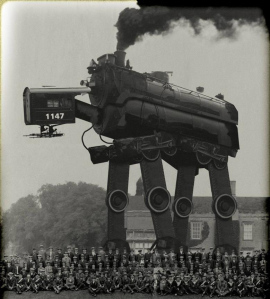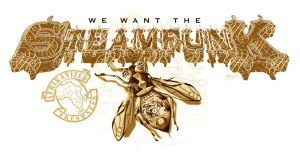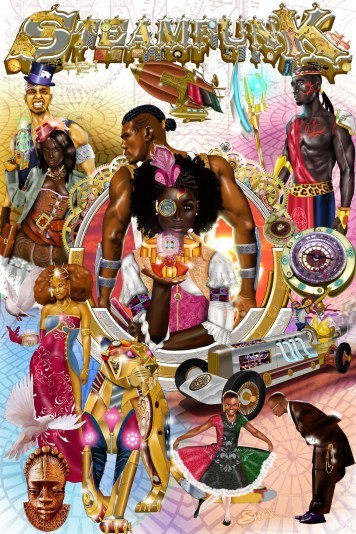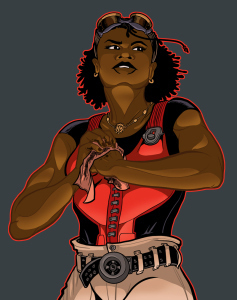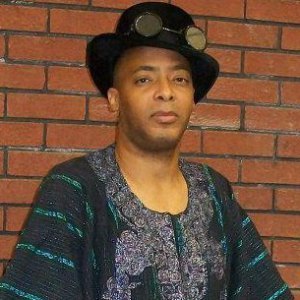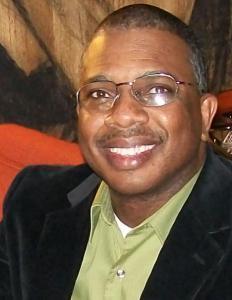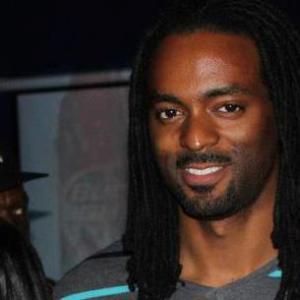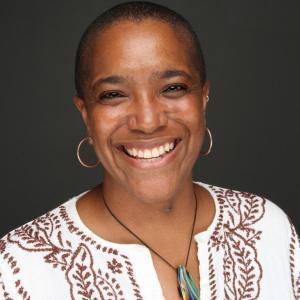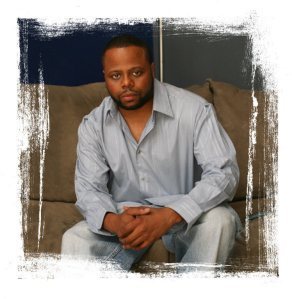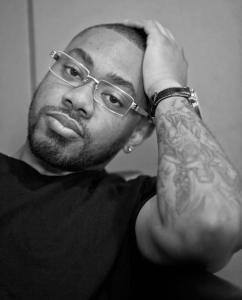Balogun Ojetade's Blog, page 29
February 20, 2013
THE MAKING OF A STEAMFUNK FEATURE FILM: The Big Budget Version!
THE MAKING OF A STEAMFUNK FEATURE FILM: The Big Budget Version
I am – at present – writing the final draft of Rite of Passage – a screenplay based on the Steamfunk series of tales, Rite of Passage, which are based on author Milton Davis’ story of the same title.
The movie will begin production in the fall.
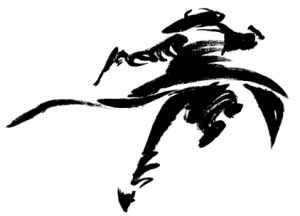 Recently, I was asked if I had a budget of one hundred million dollars, who would play the characters in the film. Since my wife has one of the lead roles as Harriet Tubman, I of course said I would keep my wife in the role of Harriet Tubman – for one, I don’t feel like sleeping on the couch; secondly, I honestly feel she has the look, toughness and movie martial arts skills required to pull off the role better than anyone else I can think of.
Recently, I was asked if I had a budget of one hundred million dollars, who would play the characters in the film. Since my wife has one of the lead roles as Harriet Tubman, I of course said I would keep my wife in the role of Harriet Tubman – for one, I don’t feel like sleeping on the couch; secondly, I honestly feel she has the look, toughness and movie martial arts skills required to pull off the role better than anyone else I can think of.
Another role I would not change is that of Dorothy Wright, played by Dasie Thames. Dasie is an exceptional actor and singer with extensive experience on the stage and screen. During our fighting and stunt boot camp – wherein we teach actors to look like warriors, soldiers, assassins and professional fighters; and professional martial artists and fighters to modify their techniques so they look good on camera, or before a live audience – Dasie picked up fight choreography with ease and, within just two hours of the camp, she was convincing as a character who had received several years of hard training in the martial arts.
As for the other roles, after long contemplation, I came up with a list.
I give you my Rite of Passage Dream Team and a peak into the main and main supporting characters of the very first Steamfunk feature film. Enjoy!
Harriet Tubman
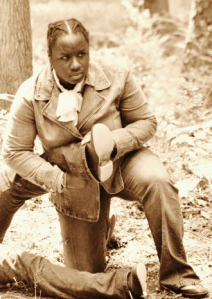 Spy, warrior and hunter of monsters and men who even monsters fear. Harriet Tubman is a conductor for the Underground Railroad, which, in the world of Rite of Passage, means she has powers, skills and access to technology far beyond the average person.
Spy, warrior and hunter of monsters and men who even monsters fear. Harriet Tubman is a conductor for the Underground Railroad, which, in the world of Rite of Passage, means she has powers, skills and access to technology far beyond the average person.
Harriet Tubman is iron-fisted mentor to the likes of John Henry and Sherlock Holmes and is self-appointed protector of the town of Nicodemus, Kansas – a western town established by African-Americans during the Reconstruction Period following the American Civil War.
ACTOR: Iyalogun Ojetade
Bass Reeves
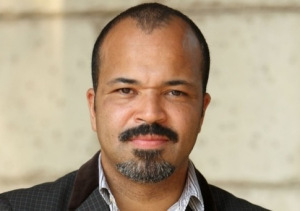 Bass Reeves’s life story is a true saga of commitment and contribution. It is a real Wild West story that very few fiction writers could have ever imagined. Bass Reeves’s law enforcement career was a testimony to a life of truth, honesty, and justice.
Bass Reeves’s life story is a true saga of commitment and contribution. It is a real Wild West story that very few fiction writers could have ever imagined. Bass Reeves’s law enforcement career was a testimony to a life of truth, honesty, and justice.
A badass of the highest order, Bass Reeves became a Deputy U.S. Marshal in 1875 at the age of 38. During his 32-year career as a Deputy Marshal, Reeves was responsible for the arrest of 3,000 violent felons and for killing 14 outlaws, without ever being shot.
Reeves possesses uncanny skills of detection and investigation, an acerbic wit and three firearms – a Sharp’s carbine and a pair of Colt revolvers – that enable him to kill the unkillable.
ACTOR: Jeffrey Wright
John Henry
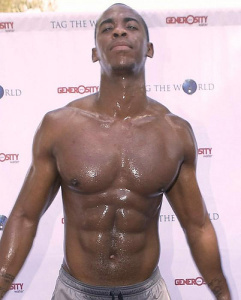 Admit it; like me, you’ve always wanted to see the Steel Drivin’ Man kick more than just a steam-powered hammer’s ass. Many an author, comic book creator and Steampunk have re-imagined John Henry’s story and in every one, I bet mountains of opened cans of whoop-ass abound.
Admit it; like me, you’ve always wanted to see the Steel Drivin’ Man kick more than just a steam-powered hammer’s ass. Many an author, comic book creator and Steampunk have re-imagined John Henry’s story and in every one, I bet mountains of opened cans of whoop-ass abound.
In Rite of Passage, John Henry has a dark past, a tortured present and an epic future.
He – and his hammers – thirsts for battle and as guardian of the town of Nicodemus – a seeming magnet for trouble and weird happenings – his cup runneth over.
ACTOR: Mehcad Brooks
Dorothy Wright

 When we first see this character, she is Dottie, a teenage runaway slave.
When we first see this character, she is Dottie, a teenage runaway slave.
A student of Harriet Tubman, who helped her escape through the Underground Railroad, Dottie trained diligently for years in the arts of combat, espionage, survival and escape. Dottie – now Dorothy – has become quite the soldier and freedom fighter in her own right and possessor of an ancient artifact that gives her some extraordinary abilities.
ACTOR: Dasie Thames (Dorothy); Sydney Park (Dottie)
Mr. Ross
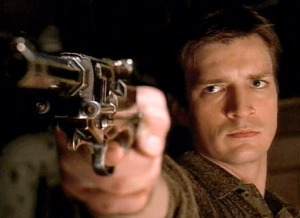 Cold; calculating; sophisticated.
Cold; calculating; sophisticated.
Mr. Ross – hired gun for ruthless businessman, P.T. Barnum – spent years as Allen Pinkerton’s executive assistant (i.e. corporate spy and fixer) before hiring himself out to the highest bidder. Skilled in investigation, assassination, provocation, interrogation and a host of other useful “ations”, Ross is one of the most valued – and feared – “fixers” in America.
A keeper of his clients’ secrets, Ross, ironically, must keep a secret of his own; a secret that – if told before its proper time – could destroy us all.
ACTOR: Nathan Fillion
Lana
 Sharp as a sword, hard as steel and tough as nails, Lana is the perfect teacher for John Henry in the ways of battle.
Sharp as a sword, hard as steel and tough as nails, Lana is the perfect teacher for John Henry in the ways of battle.
Beautiful, brilliant and wise, Lana is a woman John Henry could fall for, if she didn’t scare the hell out of him.
Lana is like a drill sergeant on steroids, but to make a man as hard as steel, can you be anything less?
ACTOR: Regina King
Akingbe
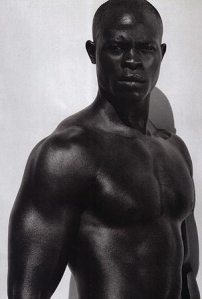 Mysterious; unstoppable; powerful beyond measure. This description just scratches the surface of who – or what – this ebon-skinned giant is. Harriet Tubman’s teacher and friend and guardian of one of the oldest and most powerful artifacts on the planet, Akingbe has lived several lifetimes and fought countless wars.
Mysterious; unstoppable; powerful beyond measure. This description just scratches the surface of who – or what – this ebon-skinned giant is. Harriet Tubman’s teacher and friend and guardian of one of the oldest and most powerful artifacts on the planet, Akingbe has lived several lifetimes and fought countless wars.
Battle hardened and world weary, Akingbe seeks to pass his burden on to another poor soul.
ACTOR: Djimon Hounsou
With the making of Rite of Passage – the first Steamfunk feature film – and the release of the Steamfunk anthology, which debuts at AnachroCon, 2013 is most certainly the year of Steamfunk!


February 18, 2013
THE NEXT BIG THING: Steamfunk, Sword & Soul and The Haunting of Truth High
THE NEXT BIG THING: Steamfunk, Sword & Soul and The Haunting of Truth High
 I’m humbled, honored and hyped to have been tagged by Blacknificent authors Quinton Veal and John F. Allen as their choices for the Next Big Thing! Thanks, so much, Quinton and John!
I’m humbled, honored and hyped to have been tagged by Blacknificent authors Quinton Veal and John F. Allen as their choices for the Next Big Thing! Thanks, so much, Quinton and John!
The rules of this blog hop are simple and sweet: 1. Answer ten questions about your current Work In Progress on your blog; 2. Tag five writers / bloggers and add links to their pages so we can hop along to them next.
So, here goes – enjoy!
What is the working title of your book?
The working title of my next novel is The Haunting of Truth High.
Where did the idea come from for the book?
Even though I am known for writing Steamfunk, Sword and Soul and Urban Fantasy, I am a horror writer at heart. I have always wanted to write a horror novel. I am also the father of seven daughters and a son. Six of my eight children read Young Adult Fiction and have asked when I will write something in that genre. A marriage of horror and YA fiction happened in my head and voila…The Haunting of Truth High was born.
What genre does your book fall under?
The Haunting of Truth High is Young Adult Horror Fiction, however, I’ve made it deep enough that adults will enjoy it too.
Which actors would you choose to play your characters in a movie rendition?
 The main character, Renay is a beautiful, intelligent and talented teen, who is very popular in and outside of school. Her life, however, is troubled and in turmoil. Renay discovers she is a warrior, born with the power to slay ghosts and other vengeful spirits. The role would require a young actress who possesses depth, but also can take on the demands of a very physical and gritty role. I think Keke Palmer would be the perfect Renay.
The main character, Renay is a beautiful, intelligent and talented teen, who is very popular in and outside of school. Her life, however, is troubled and in turmoil. Renay discovers she is a warrior, born with the power to slay ghosts and other vengeful spirits. The role would require a young actress who possesses depth, but also can take on the demands of a very physical and gritty role. I think Keke Palmer would be the perfect Renay.
 Her love interest, Shawn, who introduces Renay to the dark and frightening spectral world, hides a dark secret. Although he is young, he was raised by ghost hunters, so he has experienced things most of the world has only had nightmares about. This has made him wise beyond his years, fearless and a bit stoic; however, he is also charismatic, witty and the epitome of cool. Corbin Bleu would make a great Shawn.
Her love interest, Shawn, who introduces Renay to the dark and frightening spectral world, hides a dark secret. Although he is young, he was raised by ghost hunters, so he has experienced things most of the world has only had nightmares about. This has made him wise beyond his years, fearless and a bit stoic; however, he is also charismatic, witty and the epitome of cool. Corbin Bleu would make a great Shawn.
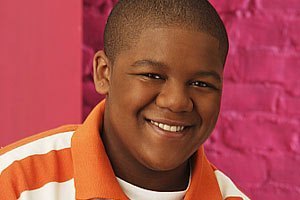 Renay’s autistic half-brother, Ricky, has the ability to see ghosts. While he cannot speak, he can draw nearly perfect illustrations of people with uncanny speed. Such a role would require an actor who can show emotions and evoke feelings without saying a word. Kyle Massey is perfect for the role of Ricky.
Renay’s autistic half-brother, Ricky, has the ability to see ghosts. While he cannot speak, he can draw nearly perfect illustrations of people with uncanny speed. Such a role would require an actor who can show emotions and evoke feelings without saying a word. Kyle Massey is perfect for the role of Ricky.
Finally, the main antagonist, Mr. Newsome, while appearing to be a lovable but firm band instructor, is sinister, creepy and the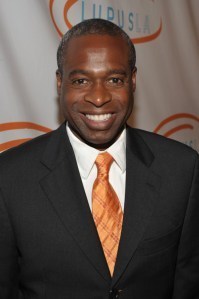 literally feeds off pain, sorrow and hatred. I would cast Phill Lewis in this frightening role.
literally feeds off pain, sorrow and hatred. I would cast Phill Lewis in this frightening role.
What is the one-sentence synopsis of your book?
A girl, whose life falls apart after the death of her father, discovers her true calling as a ghost hunter when her high school is overrun by vengeful spirits that feed on human emotions.
Will your book be self-published or represented by an agency?
The Haunting of Truth High will be self-published through my new publishing company, Roaring Lions Productions.
How long did it take you to write the first draft of your manuscript?
I am still writing it. I should have the first draft complete by May.
What other books would you compare this story to within your genre?
While there are other works of Young Adult Horror Fiction, I would say the closest comparison would be Devil’s Wake, by Tananarive Due and Steven Barnes. Devil’s Wake, while a YA novel is still scary as hell and is a great read for older folks as well. In those ways, The Haunting of Truth High is similar, even though the premises are quite different.
Who or What inspired you to write this book?
I was inspired by my love for horror movies, television and fiction and for my desire for my children to have more books with heroes who look and think like them.
What else about your book might pique the reader’s interest?
For those who read my Steamfunk, Urban Fantasy and Sword and Soul stories, you know my writing style. It is very visual, visceral, witty, and a bit frightening at times. Well, I am truly a horror writer at heart, so with The Haunting of Truth High, I went all out with the chills and thrills. Also, as a man with children who are voracious readers of YA fiction, I am intimately familiar with the YA genre and know what makes a YA book great. I also know and understand teens’ desires, goals and fears, which allows me to spin a tale that is scary, but at the same time, has heart.
Below are the links to the next chain of authors. Be sure to bookmark their sites and add their new releases to your calendars.
Milton J. Davis: Sword & Soul; Steamfunk
Talitha McEachin: Fantasy
Malon Edwards: Steamfunk; Urban Fantasy
Thaddeus Howze: Science Fiction; Fantasy
D.K Gaston: Urban Fantasy; Mystery; Thriller


February 17, 2013
STEAMFUNK DEBUTS AT ANACHROCON 2013!
STEAMFUNK DEBUTS AT ANACHROCON 2013!
This is an exciting week for me. The greatest cosmological event of all time, in my humble opinion – my bEARTHday – is February 21. You are all invited to join me in celebration. In honor of that august day (can it be august in February?), complimentary drinks are on me!
Immediately following the celebration of my 25th solar return – that’s right, I said 25th (I am a Fantasy writer, after all) – is the long-awaited release of the Steamfunk anthology!
We will debut Steamfunk at AnachroCon on February 22, 2013. For those who don’t know, AnachroCon is, by their own definition, “the premier place in the Southern United States for people to celebrate Historical Reenacting, Alternate History, Steampunk, Sciences, Horror, Etiquette & Indulgence, Fashion, Fabrication, Literature & Media, Costuming and socialize with people of like minds.” Sounds like fun…and this year, AnachroCon gets fun-ky, as thousands of Steamfunkateers converge upon the convention to witness the unveiling of an anthology chock-full-o’ steamy and funky goodness!
To help us celebrate, the good folks at AnachroCon have given Steamfunk Co-Editor, Milton Davis, a table, where contributing authors to Steamfunk will sign books and hand out free hugs and handshakes. They have also made me a Guest and I will have the pleasure of speaking on a panel or two.
So, come on by and let’s funk up AnachroCon!
Following is a list of Funkateers and their Funktastic contributions to the Steamfunk Anthology:
Ronald T. Jones – Benjamin’s Freedom Magic
Malon Edwards – Mud Holes and Mississippi Mules
Hannibal Tabu – The Sharp Knife of a Short Life
P. Djeli Clark – Men in Black
Geoffrey Thorne – The Tunnel at the End of Light
Ray Dean – A Will of Steel
Kochava Greene – The Refuge
Carole McDonnell – Oh, Western Wind
Rebecca McFarland Kyle – Once a Spider
Josh Reynolds – The Lion Hunters
Melvin Carter – Tough Night in Tommyville
Valjeanne Jeffers – The Switch
Balogun Ojetade – Rite of Passage: Blood and Iron
Milton Davis – The Delivery


February 15, 2013
THE LEAGUE OF EXTRAORDINARY BLACK PEOPLE: The Dieselpunk Edition!
THE LEAGUE OF EXTRAORDINARY BLACK PEOPLE: The Dieselpunk Edition!
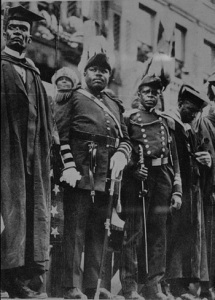 Mob bosses. Nazis. Flappers. Jazz. Bootleggers. Marcus Garvey. The Tulsa Race Riots.
Mob bosses. Nazis. Flappers. Jazz. Bootleggers. Marcus Garvey. The Tulsa Race Riots.
This is some of the stuff of the era of Dieselpunk – an often grittier sibling of Steampunk.
Dieselpunk is a sub-genre of Science Fiction and Fantasy that includes – but is not limited to, or bound by – the aesthetics, style and philosophies of film noir and pulp fiction and featuring retrofuturistic innovations, alternate history and elements of the occult. Think the movies Captain America: The First Avenger, Sin City, Hell Boy, the Indiana Jones films and The Mummy (1999 – 2008) trilogy.
Dieselpunk is set during the Diesel Era – a period of time that begins at the end of World War I and continues until the early 1950s.
Over the next few weeks, in our League of Extraordinary Black People Series, I will explore the amazing achievements of Blacks during this incredible era and will share some Dieselpunk fiction I write as well. For starters, check out my story, Lazarus Graves: The Scythe of Death. I am writing Part II to this tragic Dieselpunk tale at present and look forward to sharing that with you in the anthology Mothership: Tales from Afrofuturism and Beyond.
Some of the Dieselpunk Archetypes we will explore are:
AVENGER
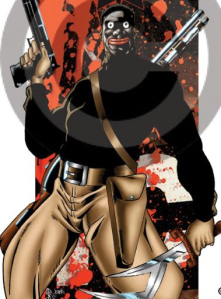 When the police don’t have the manpower to help; when the Hard-Boiled Detectives demand too much money or just don’t give a damn… there are those who will stand up for the weak, the oppressed and the victimized, fighting crime and evil in all its forms. The Avenger is a shadowy figure who strikes fear into the heart of the criminal community, hiding their true identity behind a mask, scarf, or wide brimmed hat pulled low to conceal their face. An Avenger’s motivation is rarely known. Many utilize strange inventions, chemical concoctions and / or psychic or occult powers to give themselves an advantage against their enemies.
When the police don’t have the manpower to help; when the Hard-Boiled Detectives demand too much money or just don’t give a damn… there are those who will stand up for the weak, the oppressed and the victimized, fighting crime and evil in all its forms. The Avenger is a shadowy figure who strikes fear into the heart of the criminal community, hiding their true identity behind a mask, scarf, or wide brimmed hat pulled low to conceal their face. An Avenger’s motivation is rarely known. Many utilize strange inventions, chemical concoctions and / or psychic or occult powers to give themselves an advantage against their enemies.
AVIATOR
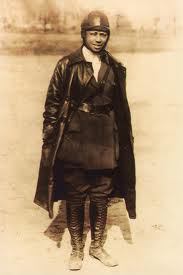 During the Diesel Era, airplanes were still a fairly new concept. Most people had never actually seen one. Many adventurers raised some money, built a plane and put on shows to exhibit their skills. Some raced their planes, while others did stunt shows such as the famous Barnstormers of the 1920’s. Industrialist Howard Hughes made much of his fortune in the burgeoning aviation industry. These daring men, more at home in the wild blue yonder than on the ground, were always on the lookout for adventure and the opportunity to make a few bucks. Others served in the war and proved themselves the Aces of the sky – modern-day knights, racing over the battlefield, delivering a hail of hell in the form of hot lead on the troops far below.
During the Diesel Era, airplanes were still a fairly new concept. Most people had never actually seen one. Many adventurers raised some money, built a plane and put on shows to exhibit their skills. Some raced their planes, while others did stunt shows such as the famous Barnstormers of the 1920’s. Industrialist Howard Hughes made much of his fortune in the burgeoning aviation industry. These daring men, more at home in the wild blue yonder than on the ground, were always on the lookout for adventure and the opportunity to make a few bucks. Others served in the war and proved themselves the Aces of the sky – modern-day knights, racing over the battlefield, delivering a hail of hell in the form of hot lead on the troops far below.
DOCTOR OF MEDICINE
The Doctor can be a general practitioner, surgeon or other specialist, a psychiatrist, or an independent medical researcher. A doctor seeks to help patients, promote a more rational and health-conscious society and, of course, to acquire money and prestige. The Psychiatrist is a Doctor of Medicine who diagnoses mental disorders and administers treatment for the same. He or she can also diagnose and treat medical conditions.
ENTERTAINER
This archetype includes dancers, singers, jugglers, stage magicians, athletes, musician, actors and anyone else who earns their living in front of an audience. It is applause, accolades, artistic expression, glory and / or money that drives them.
EXPLORER
The explorer braves the unknown, searching for long buried treasure, ancient and arcane knowledge or what lies beyond, beneath, or between.
Whether searching the wonders high in the Tibetan Mountains, at the center of the Earth, or in the depths of the sea, the Explorer will always venture where none others dare tread.
FEMME FATALE / PLAYBOY
 An irresistibly attractive man (Playboy) or woman (Femme Fatale) who uses his or her many charms to convince others to provide some good, service or favor. They are the perfect foils for a trusting, heroic adventurer who is often unfamiliar with the wily ways of these men and women. They are dangerous and willing to use their beauty – or anything else – to attain their goals. While many use their powers of enchantment for evil, others use their charms to help others, or to bring about positive change. These are usually anti-heroes who operate on both sides of law and order.
An irresistibly attractive man (Playboy) or woman (Femme Fatale) who uses his or her many charms to convince others to provide some good, service or favor. They are the perfect foils for a trusting, heroic adventurer who is often unfamiliar with the wily ways of these men and women. They are dangerous and willing to use their beauty – or anything else – to attain their goals. While many use their powers of enchantment for evil, others use their charms to help others, or to bring about positive change. These are usually anti-heroes who operate on both sides of law and order.
GREASE MONKEY
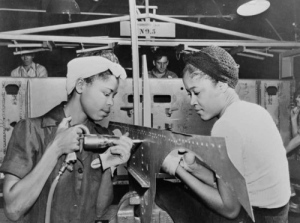 Grease Monkeys are the rough, tough and oh so ready mechanics, electricians and handymen / women of the civilian and military worlds. Aces at repairing automotives, ships, aircrafts and appliances for the home or business, these men and women keep the world moving along.
Grease Monkeys are the rough, tough and oh so ready mechanics, electricians and handymen / women of the civilian and military worlds. Aces at repairing automotives, ships, aircrafts and appliances for the home or business, these men and women keep the world moving along.
HARD-BOILED DETECTIVE
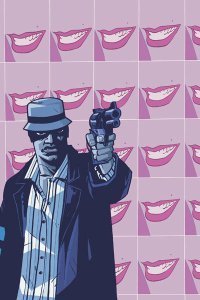 With many police departments forced to cut back on manpower from dwindling revenue, many people have turned to the private investigators for justice. Although in most cities, the “private eye” is licensed by the police and must be privately bonded as well, these gumshoes often work in the morally gray area between law and crime.
With many police departments forced to cut back on manpower from dwindling revenue, many people have turned to the private investigators for justice. Although in most cities, the “private eye” is licensed by the police and must be privately bonded as well, these gumshoes often work in the morally gray area between law and crime.
The private eye usually acts in non-police situations – gathering information and evidence for private clients in impending civil cases, tracking down fleeing or cheating spouses or business partners, or acting as agents for private defense attorneys in criminal cases. A private eye has no problem separating his or her personal feelings from the job and will gladly work for the guilty and innocent alike, as long as his fee is paid. Of course, working on both sides of the fence is tough – the police see you as a civilian muscling in on their job, and civilians view you as a rent-a-cop without the badge.
A more sophisticated cousin of the Hard-Boiled Detective is the Consulting Detective, who relies more on astute, logical reasoning and a powerful intellect than the two-fisted gumshoe.
HUNTER
 Whether they are stalking a lion across the Plains of the Serengeti in a rite to prove their worth as a man amongst their people, tracking down elephants for their ivory, bringing a museum the corpse of a Yeti for display, or riding shotgun on an archaeological expedition, there will always be a need for the Hunter – explorers of unknown lands and seekers of the next big challenge.
Whether they are stalking a lion across the Plains of the Serengeti in a rite to prove their worth as a man amongst their people, tracking down elephants for their ivory, bringing a museum the corpse of a Yeti for display, or riding shotgun on an archaeological expedition, there will always be a need for the Hunter – explorers of unknown lands and seekers of the next big challenge.
INVENTOR
Brilliant masters of gadgets and gizmos, the Inventor is intrigued by the complexities of technology and finding new uses for metal, electricity and diesel power. The Inventor is an expert in advanced mechanics and electronics, which allows him or her to create devices well beyond the normal capacities of the Diesel Era.
JOURNALIST
 These men and women seek to uncover and expose the troubles that plague the world and to make the general public aware of those troubles.
These men and women seek to uncover and expose the troubles that plague the world and to make the general public aware of those troubles.
While some might believe that to be a good journalist, you just need a notebook and a nosy disposition, in reality, you must be willing to put yourself in the thick of things to get the scoop. You must be able to skillfully use words to report and comment upon current topics and events, writing as many words in a day as an author may in a week.
Journalists work for newspapers, magazines and radio, often taking on the role of detective to bring timely and accurate news to the public. They are the eyes and ears of the city.
Constantly on the hunt for the next big story, Journalists will uncover the secrets that others need – and have a right – to know.
MAD SCIENTIST
The Mad Scientist blindly pursues knowledge and power. They gladly experiment on the living and dead alike, using brutal torture techniques to unlock the mysteries of the mind and brain and conducting breeding experiments in an effort to produce new species. These devotees of Charles Darwin and Doctor Moreau fill their island sanctuaries with animal / human hybrids, clones of themselves and loved ones and strange conglomerations of flesh and metal.
MYSTIC
 Trained in techniques from the indigenous people of Asia, Africa, or the Americas, the Mystic is an individual on a quest to discover the great secrets of the mind and body. Through meditation, study and training, they have tapped into their psychic potential. Most mystics also have extensive knowledge of the martial arts from the culture their masters hail from. This gives them a distinct advantage during the Diesel Era, as martial arts are nearly unknown in the West during this period.
Trained in techniques from the indigenous people of Asia, Africa, or the Americas, the Mystic is an individual on a quest to discover the great secrets of the mind and body. Through meditation, study and training, they have tapped into their psychic potential. Most mystics also have extensive knowledge of the martial arts from the culture their masters hail from. This gives them a distinct advantage during the Diesel Era, as martial arts are nearly unknown in the West during this period.
OCCULTIST
Occultists may be the wealthy widow, seeking supernatural truths from her deceased husband, or a champion of science, seeking to debunk the paranormal. They may be the college professor, student, or librarian who uncovers the sinister nature of the occult. Whatever the vocation or preoccupation, the occultist dedicates him or herself to the study of the unexplained. Closely related to the Occultist is the Parapsychologist – a scientist, interested in the observation of, experimentation with and measuring the power of the supernatural. Unlike the occultist, these men and women tend to be scientists, who hold degrees in physics, psychology, or medicine.
PROFESSOR
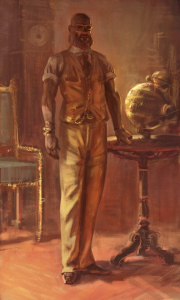 The Professor holds a Ph.D. in one or more areas of expertise and has earned tenure at some college or university. He or she is qualified to teach and has a reputation of excellence – or incompetence – in one or more field of study. Professors often become involved in adventures as they search for such things as ancient civilizations, ancient artifacts, new technologies, or contact with extra-dimensional life.
The Professor holds a Ph.D. in one or more areas of expertise and has earned tenure at some college or university. He or she is qualified to teach and has a reputation of excellence – or incompetence – in one or more field of study. Professors often become involved in adventures as they search for such things as ancient civilizations, ancient artifacts, new technologies, or contact with extra-dimensional life.
SCOUNDREL
A scoundrel excels at making her way around the law. She knows how to be stealthy, break and enter, and cover her tracks. A scoundrel may be a street thug, con artist or even a daring and stylish cat burglar or a crime lord, who oversees a criminal empire.
SPY
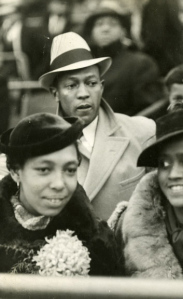 Masters and Mistresses of manipulation, charm, deceit and infiltration, the Spy pursues a life of intrigue, politics and diplomacy throughout the world. Most spies can ease their way into any group and have connections across the globe. Similar to a Consulting Detective, his or her keen senses and insight into human motivations allow him or her to notice facts and behaviors that most others miss. The Spy’s weapon is information and thorough planning – they maintain numerous cover identities and always have a contingency plan and several escape routes, should a mission go to hell.
Masters and Mistresses of manipulation, charm, deceit and infiltration, the Spy pursues a life of intrigue, politics and diplomacy throughout the world. Most spies can ease their way into any group and have connections across the globe. Similar to a Consulting Detective, his or her keen senses and insight into human motivations allow him or her to notice facts and behaviors that most others miss. The Spy’s weapon is information and thorough planning – they maintain numerous cover identities and always have a contingency plan and several escape routes, should a mission go to hell.
WARRIOR
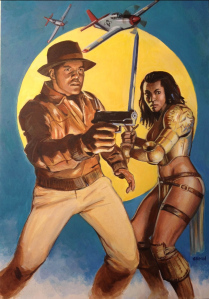 The warrior is at the forefront of battle – whether on the side of justice and heroism or in the service of selfishness, wickedness or mad schemes to rule the world. Warriors are skilled in the use of most modern weaponry, as well as basic hand-to-hand fighting techniques, tactics and strategies; many possess an expertise in a wide variety of weapons and are truly terrifying on the battlefield. Warriors range from backwater pit fighters, to bold activists, to military sharpshooters and battle-scarred veterans of world war. They make a living at the only thing they are good at – fighting, killing and surviving.
The warrior is at the forefront of battle – whether on the side of justice and heroism or in the service of selfishness, wickedness or mad schemes to rule the world. Warriors are skilled in the use of most modern weaponry, as well as basic hand-to-hand fighting techniques, tactics and strategies; many possess an expertise in a wide variety of weapons and are truly terrifying on the battlefield. Warriors range from backwater pit fighters, to bold activists, to military sharpshooters and battle-scarred veterans of world war. They make a living at the only thing they are good at – fighting, killing and surviving.
I hope you enjoyed this introduction to Dieselpunk. Be sure to hang out with us as we bring a little funk to the Jazz Age with The League of Extraordinary Black People: The Dieselpunk Edition!


February 10, 2013
STEAMFUNK FIGHTERS: Black Warriors in the Age of Steam!
STEAMFUNK FIGHTERS: Black Warriors in the Age of Steam!
 In this installment of The League of Extraordinary Black People Series, we take an in-depth look at Steamfunk fighters – incomparable warriors, who fought for glory, freedom and honor upon blood-soaked battlefields and in sweat-stained rings.
In this installment of The League of Extraordinary Black People Series, we take an in-depth look at Steamfunk fighters – incomparable warriors, who fought for glory, freedom and honor upon blood-soaked battlefields and in sweat-stained rings.
While I have a ball sharing these extraordinary people with you, I have an affinity for this archetype, as I am a warrior myself, as is my Steamfunk persona – Ogunlana – a war chief of the Oyo Empire, who brought down an invading British dirigible with the sonic vibrations from his drum. Ogunlana wears the trappings of the invaders with his traditional clothing as a warning to all that anyone who invades Oyo will suffer the same fate.
So grab a cup o’ Joe, a glass of whiskey – or a coconut smoothie, for those health-conscious warriors – sit back and enjoy, as we open a can of Steamfunk whoop-ass.
“Black” Mary Fields, aka Stagecoach Mary (1832 – 1914)
 Mary Fields was born enslaved in 1832 in Hickman County, Tennessee.
Mary Fields was born enslaved in 1832 in Hickman County, Tennessee.
She was six feet tall and weighed two-hundred pounds of muscle. “Black Mary”, as she was called, was tough, short-tempered, two-fisted and powerful and packed a pair of six-shooters and a ten-gauge shotgun that she would not hesitate to use.
Mary had a driving ambition, and loved to fight, drink whiskey and smoke homemade cigars on a regular basis.
Time and again, however, her rough-and-tumble antics were outshone by a heart of gold.
To escape slavery, Black Mary fled west, eventually making her way to Cascade County Montana as a free woman in 1884. In search of improved sustenance and adventure, she took a job with the Ursuline nuns at St. Peter’s Mission in the city of Cascade.
The nuns’ simple frontier facility was well-funded and the nuns had a thriving business converting “heathen savages”, and other “disgusting customers”, to the true path of salvation.
Mary was hired to do ‘heavy work’ and to haul freight and supplies to keep the nuns’ operation functional and well-fed. She chopped wood, did stone work and rough carpentry, dug certain necessary holes, washed laundry, managed the kitchen, and grew and maintained the garden and grounds and when reserves were low, she did one of her customary supply runs to the train stop, in Great Falls, or the city of Helena.
On one such night run, Mary’s wagon was attacked by wolves. The terrified horses bolted uncontrollably and overturned the wagon, thereby unceremoniously dumping Mary and all her supplies onto the dark prairie. Mary kept the wolves at bay for the entire night with her revolvers and rifle and, when dawn broke, got the freight delivered. Of course, the nuns docked Mary’s pay for the molasses that leaked from a keg which cracked on a rock in the overturn.
Since Mary did not pay particular attention to her fashion and otherwise failed to look and act the part of expected of a woman in the Victorian age, certain ruffian men would occasionally attempt to trample on her rights and hard won privileges. Woe to all of them.
Mary is reported by the newspaper, the Great Falls Examiner, to have broken more noses than any other person in central Montana.
Once, a hired hand at the mission, by the name of Yu Lum Duk, confronted Mary at a local saloon, where Black Mary was a regular customer, complaining that she earned two dollars a month more than he did – $9 vs. $7 – and demanded to know why she – a “colored woman” – thought that she was worth so much money anyway. He then followed that complaint up with a direct one to Filbus N.E. Berwanger, Bishop of the region, to no avail.
This infuriated Mary, who went looking for Yu Lum Duk to beat him to a pulp for the disrespect.
Fearing Black Mary’s size, strength and fighting skills, Duk drew his revolver and fired a volley of gunfire at her. Mary evaded the bullets, took cover and drew her twin revolvers.
Bullets flew in every direction until the trio of six-guns was empty, and Yu Lum Duk’s blood flowed profusely from a smoking hole in his left buttocks.
That was enough for Bishop Berwanger – he fired Mary…and gave the injured Yu Lum Duk a raise.
Out of work and needing money, Mary opened a restaurant in Cascade. Unfortunately, her cooking was horrible and the restaurant closed in short order.
In 1895, Mary landed a job carrying the United States Mail, becoming the second woman in history to have a U.S. postal route, delivering mail by stagecoach from the town of Cascade to the surrounding countryside.
Since she had always been so independent and determined, this work was perfect for her and she soon developed a reputation for delivering letters and parcels, no matter the weather, or how rugged the terrain.
Now known to all as ‘Stagecoach Mary’, she continued in this capacity until she reached well into her sixties.
Mary retired from the Postal service, but, still in need of an income at the age of seventy, she opened a laundry service, also in Cascade.
Mary didn’t do a lot of laundry, however, spending a considerable portion of her time in the local saloon, drinking whiskey and smoking her cheap cigars with the sundry assortment of men who were attracted to the place.
Mary remained a fighter in her old age. Once, a lout failed to pay his laundry bill; hearing him out in the street, she left the saloon and knocked the man flat with one blow. She was 72 years old at the time. After the man regained consciousness, she told him that the satisfaction she got from knocking him out was worth more than the bill he owed, so the score was settled.
In 1914, Mary died of liver failure. Neighbors buried her in the Hillside Cemetery in Cascade, marking the spot with a simple wooden cross which still exists today.
Manoel Henrique Pereira, aka Besouro Mangangá (1895 – 1924)
 Manoel Henrique Pereira was born in 1895, in Bahia, Brazil, to João Matos Pereira, nicknamed Joao Grosso (Big John) and Maria Haifa. When Manoel Henrique was still a young boy, he began training in a combative system of Capoeira under the tutelage Of Tio Alípio, a formerly enslaved African. These lessons took place in Trapiche de Baixo, the poorest neighborhood of Santo Amaro.
Manoel Henrique Pereira was born in 1895, in Bahia, Brazil, to João Matos Pereira, nicknamed Joao Grosso (Big John) and Maria Haifa. When Manoel Henrique was still a young boy, he began training in a combative system of Capoeira under the tutelage Of Tio Alípio, a formerly enslaved African. These lessons took place in Trapiche de Baixo, the poorest neighborhood of Santo Amaro.
Since the practice of capoeira was forbidden by Portuguese law, this training had to be done in secret. As time went by, Manoel Henrique grew, in his skills as a Capoeirista (a practitioner of Capoeira), and was soon given the nickname “Besouro Mangangá” Besouro means “beetle”; Manganga means “Devil’s Horse” – an aggressive wasp native to Brazil. He was so nicknamed because, when adversities were heavy in his life, or when the advantage of a fight was with his opponent, Besouro would simply disappear; “flying away” without a trace. So skilled was Besouro at this disappearing act, the belief that he had supernatural powers began to grow.
By train, by horse or on foot, depending on the circumstances, Besouro traveled from Santo Amaro to Maracangalha or vice versa, working on plantations, farms or mills.
As a young man in his late teens, Besouro traveled to Colonia Mill – now called Santa Elizia – in Santa Amaro, to look for work. He was authorized and became an employee there. One week later, on payday, the boss told all of the employees that no one was going to get paid. Those who dared to challenge the boss were tied to a trunk of a tree, whipped and left there for twenty-four hours. With Besouro, however, things were quite different. When the boss told Besouro he would not pay him, Besouro grabbed him by the shirt and violently forced the man to pay the money he owed.
Besouro was also notorious for getting involved in confrontations with brutal and unjust police officers. On more than one occasion, he used physical force to disarm policemen. Once armed with their guns, he would lock the policemen up in the jail cells meant for criminals.
Trouble with the police escalated until Capitan José Costa, the local police commander, assigned 10 men to catch Besouro dead or alive. While hanging out in a local bar one night, Besouro had a vision of the police coming for him. He left the bar and went to the main square. When the police arrived, he walked up to the Christian cross that was in the square, where he proceeded to spread his arms out as if he was crucified and shouted to the police that he would never surrender to them. The night air was torn asunder by the thunderous din of gunshots. A moment later, Besouro collapsed. Capitan Costa walked up to Besouro and probed him with his gun.
“Besouro is dead,” the commander bellowed.
Besouro, however, was very much alive and to the great surprise of everyone, snatched the Capitan’s rifle from his fingers. He then ordered all the police officers to put down their guns and leave the square. Besouro sang a cheerful song as the cops left the square unarmed.
Capitan Costa grew even more determined to see Besouro dead and one morning, Besouro found himself surrounded by a group of about 40 police officers. The cops shot at him with a hail of gunfire. The Capoeirista was unscathed, however, dodging the bullets by moving his body to the rhythm of the guns.
A man soon arrived, whom history remembers as Eusebio de Quisaba. This mysterious man charged Besouro and brutally stabbed him with a knife made of ticum, a type of hardwood significant to practitioners of the Afro-Brazilian spiritual tradition of Candomblé. Candomblé folklore says that this wood is the only way to kill a man whose body and spirit are “closed”, or impervious, to death. Besouro was believed to be just such a man, in possession of a “corpo fechado” – which literally means: “closed body” – a body that, through special rituals, has become impenetrable by knives or bullets.
A day later, Besouro Mangangá died of his wounds. The year was 1924.
Today Besouro is a symbol of heroism and of Capoeira throughout all of Brazil. His bravery and loyalty and the support he gave to the persecuted and oppressed has not been forgotten.
Joe Gans (1874 – 1910)
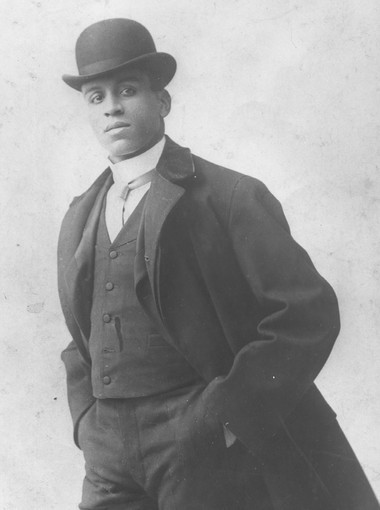 Joe Gans (25 November 1874 – 10 August 1910) was born Joseph Gant in Baltimore, Maryland.
Joe Gans (25 November 1874 – 10 August 1910) was born Joseph Gant in Baltimore, Maryland.
Rated as the greatest lightweight boxer of all time, the “Old Master” – as he was called by friends, fans and foes, alike – fought professionally from 1891 to 1909.
Gans was the first African-American World Boxing Champion, reigning continuously as World Lightweight Champion from 1902 to 1908.
Gans’ first fight, however, was against poverty; a formidable opponent indeed. Gans eventually prevailed and with his earnings from the fight dubbed the ‘Greatest Fight of the Century’ – a brutal, grueling 42-round fight that remains the longest title fight in history and the longest fight ever caught on film – he built the Goldfield Hotel in Baltimore. The Goldfield was home to the Goldfield Hotel Jazz Club, which was a precursor to the Cotton Club and the place where Gans gave musician Eubie Blake his first big opportunity.
Gans was a master of defensive fighting, as well as a devastating puncher. He attacked the vital points on his opponents’ bodies with pinpoint accuracy and threw perfect combinations with bewildering speed. He was a master of counter-punching, of the art of feinting, and the art of body-punching. He was a complete fighter, with great speed, power, punching ability and a killer instinct.
Gans had a remarkable ability to stop his opponent’s punches and he is considered, by many, as perhaps the best fighter ever at blocking and evading blows.
John L. Sullivan, former heavyweight champion of the world, said, in the St. Louis Post Dispatch, Sep. 2 1906, “I never liked a Negro as a fighting man…but Gans is the greatest lightweight the ring ever saw. He could lick them all on their best day. Gans is easily the fastest and cleverest man of his weight in the world. He can hit like a mule kicking with either hand.”
On December 8, 1903, Gans fought the great welterweight, Sam Langford, the most avoided fighter in boxing history.
The fight took place in Boston the day after Gans fought a no decision bout against Black welterweight Dave Holly in Philadelphia (Gans won the newspaper decision). This means that Gans had to travel by train up the eastern seaboard from Philly to Boston for a fight the very next day. Gans admitted that fighting two days in a row and making the trip had sapped his stamina. Nevertheless, he dominated Langford early in the fight before fading from lag in the later rounds and losing a close decision.
This fight is the only one Gans lost in a period of more than ten years. Considering it was his second fight within 24 hours in cities 300 miles apart and the quality of his opposition, Gans did very well indeed.
When Joe Gans got his shot at champion Frank Erne, on May 12, 1902, he wasted no time in gaining the title with a sensational first round knockout at 1:40 of the round.
After winning the lightweight title, Joe Gans successfully defended it 17 times.
The Joe Gans-Battling Nelson fight in Goldfield, Nev. on Sep. 3, 1906 rates as the greatest lightweight championship bout ever contested. For 42 hard-fought rounds – the longest gloved championship match recorded under The Marquis of Queensbury’s rules – the two lightweights engaged in a titanic struggle.
Joe Gans was forced to fight at unnaturally low weights for much of his career. Even though he was champion, he often had to succumb to the dictates of his white opponents. Gans had trouble making 133 pounds ringside several times. If he were fighting today he would be a natural 140-pound fighter, though since he would not have to make weight ringside, he could easily make the 135-pound limit. In the first Nelson fight he was forced to make 133 ringside in full gear, this combined with the dehydrating Nevada sun and the grueling 42 round fight may have contributed to Gans contracting tuberculosis – an infectious disease that attacks the lungs, causing difficulty in breathing, weakness, fatigue, chills, chest pain, and sometimes coughing blood – which was one of the leading causes of death in that day.
Gans was suffering the ravaging affects of tuberculosis when he lost the title, in a rematch, to Battling Nelson on July 4, 1908. The San Francisco Chronicle described Gans as “weakened and dull in the eyes” and said, “It was clear that it was a different Gans than the one who had fought at Goldfield.” Even more revealing was the report that “After the twelfth round Gans was suffering terribly. His skin turned a dull gray and he was shivering as though from ague (fever). It seemed as though his vitality had been stolen from him.”
Despite his devastating illness, the first five rounds were Gans’ by a wide margin. In the second round an uppercut staggered Nelson; and in the third, Gans drew blood. However, he was so weakened by the disease that was killing him that he began to fade. Despite being desperately sick, Gans fought on before succumbing, as he said “to exhaustion” in the 17th round.
Gans and Nelson fought again two months later. Gans made it 21 rounds this time – a feat of will and strength that defies logic and reason. He again dominated the early rounds with well-timed and accurate punches. For the first few rounds Gans looked like the master of old, using elusive ducking and sidestepping movements and cutting Nelson open with lightning quick jabs and devastating crosses. But eventually the Dane’s fierce body punching wore down Gans’ emaciated body.
In both fights, under modern 12-round rules, Gans would have gone the distance and probably even won.
Gans fought one more time against former British champion Jabez White. Even though his body was a mere shell of its former self, Gans still displayed some of his famous punching power and speed, dropping White several times and even knocking the Brit out twice in the match, but both times, the Bell saved him from a loss. The fight was officially named a no decision bout but Gans easily won the newspaper verdict.
The following year, Gans died in his mother’s arms. When he died, he only weighed 84 pounds.
Joe Gans is hailed by many fight experts as the greatest fighter of all time, regardless of weight and by the majority as the greatest lightweight in history.
These mighty warriors of the Age of Steam battled adversity, fought hardship and struggled against overwhelming odds to emerge as champions. These men and women of indomitable spirit are shining examples of The League of Extraordinary Black People!


January 26, 2013
THE STATE OF BLACK SCIENCE FICTION 2013: Countering Negative Images of Blacks in the Media!
THE STATE OF BLACK SCIENCE FICTION 2013: Countering Negative Images of Blacks in the Media
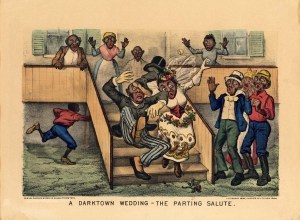 From posters that advertised slaves for sale in the 1500s, to the lumping of Zane’s erotica with Charles Saunders’ Sword and Soul on the same shelf in the bookstore today, there has been an unrelenting, powerfully persuasive and seeming purposeful, effort to promote black inferiority in the media. For every positive image of African-Americans, there are 100 negative stereotypes; sadly, many of them perpetrated by Black people.
From posters that advertised slaves for sale in the 1500s, to the lumping of Zane’s erotica with Charles Saunders’ Sword and Soul on the same shelf in the bookstore today, there has been an unrelenting, powerfully persuasive and seeming purposeful, effort to promote black inferiority in the media. For every positive image of African-Americans, there are 100 negative stereotypes; sadly, many of them perpetrated by Black people.
Images and words combined are very powerful, and have been used, quite effectively, to convey this whole idea of African-Americans being “less than”; “not as good as”: the myth of Black inferiority.
And the concomitant myth of white superiority.
Black inferiority is a myth that had to be created in order to justify slavery within a democracy. These two contradictions – slavery and democracy – had to be reconciled, and the only thing the good old U.S. of A. could come up with was the declaration and substantiation that slaves were not human.
 We must realize that we are not talking about ancient history, either. We have slave narratives that were written in the 1930s. The tragedy and horror of chattel slavery happened only a few generations ago. And the inferiority that was drummed into us through the media – through propaganda – has passed down from generation to generation just like a favorite family recipe.
We must realize that we are not talking about ancient history, either. We have slave narratives that were written in the 1930s. The tragedy and horror of chattel slavery happened only a few generations ago. And the inferiority that was drummed into us through the media – through propaganda – has passed down from generation to generation just like a favorite family recipe.
This sickness must be addressed.
If you have a malignant tumor, you cannot just wait for it to dissipate. It will not just go away. It will spread. The disease of institutionalized racism in the media has been a cancer that we have hoped would just go into remission, but it has spread and now, the whole planet has bought into these myths.
We have become insensitive or desensitized to the point we are unconscious of what we see, hear and what is going into our minds. We have become a party to our own brainwashing. We have joined in and become our own victimizers.
In the old days, you had white comedians putting on black cork and basically humiliating and ridiculing Black people. Fast-forward a few years, when we were given this illusion called “progress”. Black comedians said to the white comedians “Hey, you don’t have to ridicule and humiliate us, we’ll do it. We’ll take it from here, boss.”
And they took it from there…and carried it straight to Hell.
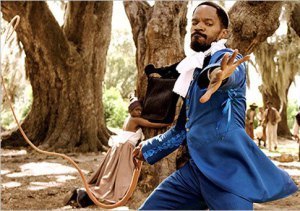 Let’s take the use of the word “nigger”, for example; so talked about now because of its use 110 times in the movie Django Unchained. Black comedians took this wicked, destructive word and took ownership of it as if to call ourselves a nigger was empowering, as if it was a term of endearment and still vehemently defend its use to this very day. And no, saying “the N-word” is no better. It is just foolish.
Let’s take the use of the word “nigger”, for example; so talked about now because of its use 110 times in the movie Django Unchained. Black comedians took this wicked, destructive word and took ownership of it as if to call ourselves a nigger was empowering, as if it was a term of endearment and still vehemently defend its use to this very day. And no, saying “the N-word” is no better. It is just foolish.
The historian Carter G. Woodson said that African-Americans have been basically conditioned to go around to the back door, and if there is no back door, we will insist on one.
If you can get a Black comedian to show up on a late-night talk show and act the clown, it’s comforting to those people who say, “See they are a happy people. They aren’t angry with us for five hundred years of slavery and oppression.” It is like approaching a dog you have abused, neglected and chained up in your kitchen for a week, thinking “Boy, I sure hope it doesn’t bite.” And if, instead of tearing out your throat, the dog starts wagging its tail, you breathe a sigh of relief and say “Whew, good dog.”
It is a toxic mix – white supremacy, white superiority, and black inferiority.
Why we expect so little of ourselves and of each other
 There are several reasons for this sad and unfortunate truth.
There are several reasons for this sad and unfortunate truth.
For starters, lower expectations mean fewer disappointments.
We have become comfortable with negative behavior; with poor performance.
Recently, my students and I met at a local, Black-owned vegetarian / vegan restaurant for a meeting. The restaurant, scheduled to open at 11:00am, was closed. It was noon when we arrived. This was not the first time this had happened and I suggested we go somewhere else, but everyone – except yours truly – was set on eating at this place.
Time crept on. 12:30pm…12:45pm…1:00pm.
Finally, at 1:15pm, the owners drove up, walked by us without even a “Hello”, let alone an apology for their extreme lateness, and entered the restaurant.
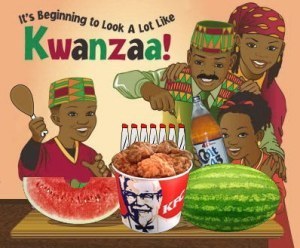 My students and I followed. I asked if they had anything already prepared that we could eat and they informed me that they prepare their food daily, so I would have to wait. I informed the owner that we had already been waiting for an hour and that they were supposed to be open at 11:00. The owner shrugged her shoulders and said “We have lives outside of this restaurant. Don’t you have a life outside of your job?”
My students and I followed. I asked if they had anything already prepared that we could eat and they informed me that they prepare their food daily, so I would have to wait. I informed the owner that we had already been waiting for an hour and that they were supposed to be open at 11:00. The owner shrugged her shoulders and said “We have lives outside of this restaurant. Don’t you have a life outside of your job?”
As a business owner who goes above and beyond to satisfy my students and those who read my books and watch my films, I was shocked and furious. I told my students that I was leaving and would never spend another dime with those fools. My students all said that we need to give Black businesses second, third and forth chances. And that as “conscious” Black folks we must be even more forgiving.
I said “Consciousness has nothing to do with it! We have to demand excellence from Black businesses and cease this acceptance of Black mediocrity or we will remain mediocre!” I then hugged everyone and left. I have never returned to that restaurant. And never will.
 From kindergarten through fourth grade, I attended Sol R. Crown Elementary School in a poor neighborhood on the West Side of Chicago. At Crown, being smart and working hard was interpreted as acting white. Because to be smart, was also to be different. And to be different meant that you were trying to be better than those who were not striving.
From kindergarten through fourth grade, I attended Sol R. Crown Elementary School in a poor neighborhood on the West Side of Chicago. At Crown, being smart and working hard was interpreted as acting white. Because to be smart, was also to be different. And to be different meant that you were trying to be better than those who were not striving.
When I was in kindergarten, one day my class was counting from one, through ten. My voice seemed to stick out from the rest of the group for some reason. The substitute teacher – a Caucasian woman who appeared to be in her early forties and mean as a junkyard dog fed a steady diet of gunpowder and guinea peppers – seemed to notice too and she singled me to count by myself. “Won…too…th-REE…for…” I said, pronouncing the words carefully and correctly, as my mother and sisters taught me. “…fiv…” The students laughed at the way I properly said five. They also laughed at my “nin” and my “tehn”, saying “It ain’t ‘fiv’, it’s ‘fahv’; it’s not ‘nin’, it’s ‘nahn’; and it shol’ ain’t ‘tehn’, it’s ‘tin’.”
I challenged them and said they were “talking country” (“talking country” means to speak in an unsophisticated manner, usually associated with the drawl of the rural American South) and asked the teacher who was right. The teacher told them I was wrong and that the “country” way they said the numbers was the “proper way for your people to say it.”
And no, this was not in Yazoo, Mississippi in the 1800s. It was 1972 in Chicago, Illinois.
 Even today, if a Black person is articulate and does not use slang, some of us will say that person is acting “white”.
Even today, if a Black person is articulate and does not use slang, some of us will say that person is acting “white”.
The media is directly responsible for this. The perpetuation of stereotypes is always done through print, television, film, radio, music and, now, the internet.
Flip the channel or turn the page and there are the “baby mamas” and “baby daddies” so ubiquitous in common American culture that they become plot points or titles for mainstream comedies and movies.
The syndicated television program Maury, hosted by Maury Povich, is known for its “Who’s Your Daddy?” segments. Much of the content is based on issuing paternity tests to teens and young adults in hopes of determining fatherhood.
Many of Maury’s guests are black, and the sheer number of these cases is damning. Shows like these, along with court television shows that promote the same dysfunction, are very popular.
Millions of viewers are indoctrinated by these images of black family chaos. And we watch these programs like a gory highway car wreck because they involve so many people who look like us.
And we accept and share these perceptions without question, qualm or quarrel.
At a very young age, Black men and women are inundated with messages that they cannot trust or depend upon one other. Children see images of – and hear comments and jokes about – lazy, greedy, irresponsible, or otherwise flawed Black adults.
Black characters have appeared in American films since the beginning of the industry in 1888, but Black actors were not even hired to portray Black people in early works. Instead, white actors and actresses were hired to portray the characters while in “blackface.”
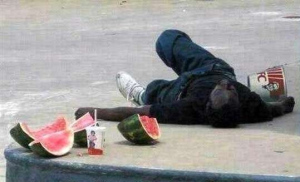 In addition, Black people were purposely portrayed in films with negative stereotypes that reinforced white supremacy over Black people. Since motion pictures have had more of an impact on the public mind than any other entertainment medium in the last ninety years, this has had a tremendous effect on society’s view of Black people.
In addition, Black people were purposely portrayed in films with negative stereotypes that reinforced white supremacy over Black people. Since motion pictures have had more of an impact on the public mind than any other entertainment medium in the last ninety years, this has had a tremendous effect on society’s view of Black people.
The media sets the tone for the morals, values, and images of our culture. Many people in this country believe that the degrading stereotypes of Black people are based on reality and not fiction. Everything they believe about us is determined by what they see on television. After over a century of movie making, these horrible stereotypes continue to plague us today, and until negative images of Black people are extinguished from the media, we will be regarded as second-class citizens.
The Solution
 We have not come that far since 1914, when Sam Lucas was the first black actor to have a lead role in a movie for his performance in Uncle Tom’s Cabin.
We have not come that far since 1914, when Sam Lucas was the first black actor to have a lead role in a movie for his performance in Uncle Tom’s Cabin.
1915 is a significant date in motion picture history because D.W. Griffith released The Birth of a Nation, which supported the Ku Klux Klan and is possibly the most anti-Black film ever made.
The National Association for the Advancement of Colored People (NAACP) worked very hard to try to ban the film due to its vicious portrayal of Black people as subhuman compared to the glorified Ku Klux Klan. The Birth of a Nation was important because it led to the creation of a new industry that produced “race films” for African-Americans. These films portrayed us in a positive light and addressed many social concerns of the community.
Before “race films,” Black people were nothing more than shuffling, shiny-faced, head-scratching simpletons with bugged out eyes who leaned on brooms and spoke bad English, but after the introduction of “race films,” we were depicted with more dignity and respect.
In order for Black people to ensure that they would have positive roles and stop reinforcing negative stereotypes through film, we had to make our own movies. The same holds true today.
I am asked, quite often, if there is such a thing as a Black Science Fiction movie. Supposing by “Black Science Fiction movie”, they mean a science fiction or fantasy movie that features a Black protagonist and majority Black cast and deals with issues that strongly impact Black people, I tell them that Black Science Fiction movies began in 1939, with the release of Son of Ingagi and that filmmakers continue to make quality Black Science Fiction movies today.
On Thursday, February 7, 2013, we will explore this topic in-depth and present solutions at the Black Science Fiction Film Festival during the panel discussion entitled The State of Black Science Fiction: Countering Negative Images of Blacks in the Media.
This amazing discussion includes:
BALOGUN OJETADE, Co-Moderator
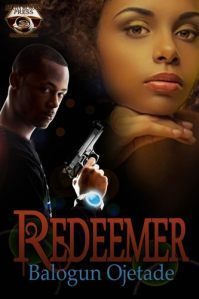 Balogun is the author of the bestselling Afrikan Martial Arts: Discovering the Warrior Within and screenwriter / producer / director of the films, A Single Link and Rite of Passage: Initiation.
Balogun is the author of the bestselling Afrikan Martial Arts: Discovering the Warrior Within and screenwriter / producer / director of the films, A Single Link and Rite of Passage: Initiation.
Balogun is one of the leading authorities on Steamfunk – a philosophy or style of writing that combines the African and / or African American culture and approach to life with that of the steampunk philosophy and / or steampunk fiction – and writes about it, the craft of writing and Steampunk in general, at http://chroniclesofharriet.com/.
He is author of four novels – MOSES: The Chronicles of Harriet Tubman (Books 1 & 2) (Steampunk); Redeemer (Science Fiction); Once Upon A Time In Afrika (Sword & Soul) and the Sword and Soul anthology, Ki-Khanga. In February, 2013, Balogun – with Co-Editor Milton Davis – will release the Steamfunk anthology.
Balogun is Master Instructor of the Afrikan Martial Arts Institute and Technical Director of Martial Ministries of America, a non-profit organization that serves at-risk youth. He is also a traditional African priest, actor and conflict resolution specialist, who works and lives in Atlanta, Georgia with his wife, his seven daughters and his son.
MILTON J. DAVIS, Co-Moderator
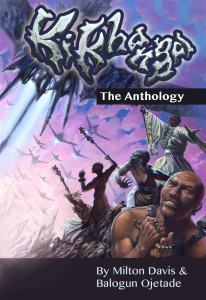 Milton Davis is a chemist by day and a writer/publisher by night and on the weekends. He writes and publishes uplifting science fiction and fantasy stories from an African-American perspective because he feels that there is a lack of positive black characters in the speculative fiction market.
Milton Davis is a chemist by day and a writer/publisher by night and on the weekends. He writes and publishes uplifting science fiction and fantasy stories from an African-American perspective because he feels that there is a lack of positive black characters in the speculative fiction market.
Milton is the author of four novels: Meji Book One, Meji Book Two, Changa’s Safari Vol. 1, Changa’s Safari Vol. 2 and two anthologies: Griots: A Sword & Soul Anthology, for which he is a contributing editor, along with sword and sorcery living legend – and founder of the fantasy subgenre, Sword and Soul – Charles R. Saunders and co-author – with Balogun Ojetade – of Ki-Khanga: The Anthology, a book based on Ki-Khanga: The Sword and Soul Role-Playing Game.
A man who wears many hats and wears them well, Milton is producer of the Steamfunk film, Rite of Passage: Initiation, which is based on his short story, Rite of Passage.
In February, 2013, Milton and Balogun team up again, releasing the highly anticipated Steamfunk anthology worldwide.
All of Milton’s works are self-published through his company, MVmedia, LLC.
DONNIE LEAPHEART
 Filmmaker extraordinaire Donnie Leapheart is the award-winning writer, director, producer and editor of the hit web series, Osiris, winner of the coveted Best Web Series award at the prestigious American Black Film Festival.
Filmmaker extraordinaire Donnie Leapheart is the award-winning writer, director, producer and editor of the hit web series, Osiris, winner of the coveted Best Web Series award at the prestigious American Black Film Festival.
Osiris is an independent science fiction thriller with gritty elements of crime fiction, espionage and the supernatural.
Donnie has also edited and / or produced several documentaries and films, including The Walk, starring Eva Marcille (Pigford); the Soul Train Awards; and Paul Mooney’s Jesus is Black-So was Cleopatra-Know Your History.
Donnie creates his films and web series through his production company, Pyramid Pictures.
TERÉSA DOWELL-VEST
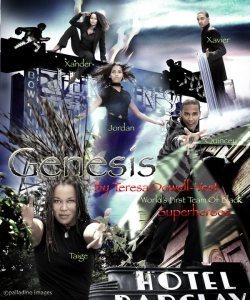 Terésa Dowell-Vest is a writer, director, and production designer for the stage and film.
Terésa Dowell-Vest is a writer, director, and production designer for the stage and film.
She has taught acting and producing at the American Musical and Dramatic Academy in Hollywood and was the first Program Director of the African American Heritage Program at the Virginia Foundation for the Humanities at the University of Virginia.
An accomplished professional photographer and author of poetry, stageplays and short stories, Terésa is the creator of the bestselling book of poetry and reflections, Hot Sauce & Honey and the coffee table book, The Box 69: A Photo Blog Series…a Photographic Chronicle in Verse, Song, and Crayons.
She is the writer, director and producer of Genesis: New American Superheroes, a feature film that is now in production and that is to soon cross-over into a series of novels and a video game.
Terésa can be reached at Diva Blue’s Blog.
TOMMY BOTTOMS
 Tommy Bottoms, an Indiana native who now resides in Atlanta, GA, is a cultural and media critic as well as an HBO Def Poetry Jam alum. His 10 year career in spoken word and writing has garnered him critical acclaim in poetry and academia circles from Los Angeles to London. Because of Tommy’s ability to dissect complex topics in a witty and frank manner, he has been invited to speak at various universities around the country, including Penn State Law School and Harvard University.
Tommy Bottoms, an Indiana native who now resides in Atlanta, GA, is a cultural and media critic as well as an HBO Def Poetry Jam alum. His 10 year career in spoken word and writing has garnered him critical acclaim in poetry and academia circles from Los Angeles to London. Because of Tommy’s ability to dissect complex topics in a witty and frank manner, he has been invited to speak at various universities around the country, including Penn State Law School and Harvard University.
His The Tommy Bottoms Report provides breaking news and in-depth analysis of politics and culture from an urban perspective.
Tommy is producer of the popular web series, Eternal, appropriately described as True Blood meets The Wire.
Tommy can be reached at tommy.bottoms.7@facebook.com or on Twitter @eternaltheshow.
LARON AUSTIN
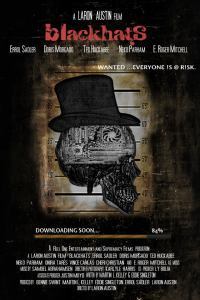 LaRon Austin is the director of the acclaimed music documentary Beat Makers and the hit feature film Step Off, from Lionsgate Films.
LaRon Austin is the director of the acclaimed music documentary Beat Makers and the hit feature film Step Off, from Lionsgate Films.
LaRon’s feature film, blackhats – an action-packed science fiction thriller, already described by many as “an indie mini-blockbuster” – is slated for an early 2013 release.
LaRon can be reached at http://blackhatsmovie.blogspot.com/.
So, walk, crawl, bicycle, or rent a blimp…whatever it takes to make it out to the Black Science Fiction Film Festival at GA-Tech. You do not want to miss this!


January 23, 2013
STEAMFUNK ENCHANTERS: Black Magicians, Conjurers and Soothsayers in the Age of Steam!
STEAMFUNK ENCHANTERS: Black Magicians, Conjurers and Soothsayers in the Age of Steam!
We return to our League of Extraordinary Black People series with a look at the great men and women whose lives were bolstered, or broken, by the arts of legerdemain, divination and prestidigitation. These virtuosos of voodoo, stage magic, fortune-telling and mesmerism all came to fame through the workings of the arcane.
Previously, we explored Dandies, Adventurers, Activists, Tinkerers and the Black Dispatches. Join us now, as we examine the lives and amazing abilities of more extraordinary Black people from the Age of Steam(funk)!
Richard Potter (1783 – 1835)
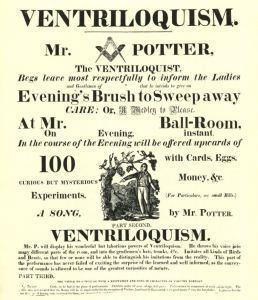 Born July 19, 1783, Richard Potter is celebrated as the first successful stage magician in America.
Born July 19, 1783, Richard Potter is celebrated as the first successful stage magician in America.
Potter was born in New Hampshire, the son of an English baronet and an African servant woman. He was educated in Europe before beginning his 25-year career as a performer in post-Revolutionary America. He lived with his father in Hopkinton, NH, until he married his wife, Sally, and had three children.
Potter is also credited as America’s first successful hypnotist and ventriloquist. One of the earliest records of his stage shows is November 2, 1811, in Boston at the Columbian Museum. The performance featured ventriloquism and magic. Potter is believed to be the first to use a ventriloquist’s dummy and could skillfully throw his voice, using human speech and sounds that perfectly imitated the chirping, cooing and caws of birds.
Potter performed in Boston, throughout New England, and Canada. Witnesses of Potter’s shows say he was able to walk through a log. The crowd that watched him do this assumed the log was hollow. But when they checked out the log for themselves they discovered it was completely solid! Another of Potter’s amazing tricks was his ability to take a ball of yarn and toss it high into the air, where it would slowly unravel. Potter would then climb up the yarn and vanish into the clouds to vanish before hundreds of spectators.
His shows also regularly included prestidigitation with eggs, money, and cards; throwing knives at assistants; touching a hot iron to his tongue; walking on flames; and dancing on eggs without breaking them.
Potter was very successful and it is said that he made $4800 for 20-day engagements in the early 1800s, allowing him to buy a 175-acre farm in Andover, New Hampshire, in the village now known as Potter’s Place. His story intrigued Harry Houdini, who became a huge fan.
JK Rowling, author of the mega-successful Harry Potter series of novels, explains the supposed origin of Harry Potter’s name: “Harry’ has always been my favourite boy’s name, so if my daughter had been a son, he would have been Harry Rowling. Then I would have had to choose a different name for “Harry” in the books, because it would have been too cruel to name him after my own son. “Potter” was the surname of a family who used to live near me when I was seven years old and I always liked the name, so I borrowed it.” However, sources close to Rowling say that she named the popular teen magician after famed stage magician Harry Houdini and his idol – the first known stage magician in America – Richard Potter.
Potter died on September 20, 1835. Sometime after his death and the death of his wife, Sally, the couple was buried in the front yard of their estate. A few years afterward, however, the house burned down. Potter and his wife’s graves were moved to their present site in 1849. All that remains to this day is a small plot with the gravestones behind the railroad station at Potter’s Place.
Marie Laveau (1794 – 1881)
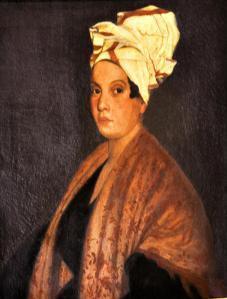 Recognized as the Voodoo Queen of New Orleans, there is no magician, conjurer, witch, or fortune teller who has risen in status or fame to rival Marie Laveau.
Recognized as the Voodoo Queen of New Orleans, there is no magician, conjurer, witch, or fortune teller who has risen in status or fame to rival Marie Laveau.
Marie Catherine Laveau was born in New Orleans on September 10, 1794, the daughter of two free Blacks – Marguerite Darcantel, a former Haitian slave and Charles Laveau, a wealthy, Black plantation owner of mixed race.
Raised by her mother and grandmother, both Voodoo priestesses, Marie Laveau spent most of her adult life in a world where Voodoo was neither alien nor uncommon. She was a very spiritual person who blended, in the Creole way, Voodoo with Catholicism, especially the saints. For Laveau, Voodoo was an extension of Catholic practices and Catholicism, a focus toward the same Bon Dieu (God), natural and familiar, to Voodoo.
Laveau married a Jacques Paris in 1819 and went to live in New Orleans’ French Quarter. For whatever reason, Charles Paris was soon died, however, and she was left with two children to care for.
After Jacques’ passing, the “Widow Paris” worked as a hairdresser and as a nurse, even performing minor surgery when necessary. Her nursing duties included ministering to prisoners on death row as well as taking in the sick to be nursed in her home. During the worst breakouts of Yellow Fever and Cholera, Laveau was a saint who saved many, and helped make the transition to death a comfortable one. She was there, in the worst hospital wards, using her knowledge of herbal medicines and Voodoo prayers to save the dying. This was frowned on by the local church, but nobody could stop her.
Being a free woman of color meant that “Mam’zelle Laveau” was free to own slaves. She took advantage of this…not to make life easier on herself, but to put herself in a position to free her enslaved people.
She entered into a common-law marriage with Christophe Glapion, a member of a prominent local family, and they had five children together – only two of whom survived to adulthood. Although Marie never abandoned her Catholic roots, she became increasingly interested in her traditional African beliefs and quickly developed a reputation as New Orleans’ leading voodoo queen.
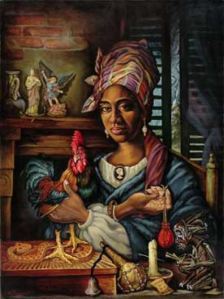 While voodoo was commonly practiced in New Orleans, it had a fearsome reputation and a history of fueling revolution and slave revolts and was actually banned at different times in Louisiana history. Marie Laveau’s marriage of voodoo beliefs to Catholic traditions helped make voodoo and more acceptable to upper-class New Orleans society. She regularly presided over public voodoo ceremonies in Congo Square – one of the few locations in rigidly segregated New Orleans where people of different races could mix freely – and made a good income selling charms, curses, and blessings to people of all social classes. The fact that many of her clients were servants in upper-class homes also gave her a spy network which helped reinforce her supernatural reputation to the wealthy patrons who asked for her services.
While voodoo was commonly practiced in New Orleans, it had a fearsome reputation and a history of fueling revolution and slave revolts and was actually banned at different times in Louisiana history. Marie Laveau’s marriage of voodoo beliefs to Catholic traditions helped make voodoo and more acceptable to upper-class New Orleans society. She regularly presided over public voodoo ceremonies in Congo Square – one of the few locations in rigidly segregated New Orleans where people of different races could mix freely – and made a good income selling charms, curses, and blessings to people of all social classes. The fact that many of her clients were servants in upper-class homes also gave her a spy network which helped reinforce her supernatural reputation to the wealthy patrons who asked for her services.
The dark consultation of Marie Laveau was sought by the many great men and women of New Orleans. They would visit with Laveau at her St. Ann cottage, sit with her and discuss business matters and affairs of the heart. After fully understanding the situation, Marie would give them advice on how to proceed and insight into their past, present and future…and she was always right.
Marie disappeared for a time. It is said that she went off to train with a famous Voodoo priest named Doctor John, who was believed to be a free Black man with so much experience in dark magic, that he has never been discovered because of this power.
In 1830, several years after her disappearance, Marie returned as Voodoo Queen, now armed with the most potent rituals, a pet snake named Li Grande Zombi, and, it seemed, eternal youth.
Marie Laveau had an extremely complex reputation in later life, both feared for her power as a voodoo queen – with numerous stories about the things that “happened” to anyone who offended her – and admired as a living saint due to her humanitarian work.
At the time of her death in 1881, eminent writer Lafcadio Hearn referred to her as “one of the kindest women who ever lived”. Her fame also guaranteed prominent obituaries in the New Orleans Times-Picayune and the New York Times.
After the announcement of her death, however, many witnessed Marie Laveau walking the streets of the French Quarter as she always did and to this very day people claim to see Marie Laveau walking about on her beloved St. Ann Street.
Mary Ellen Pleasant (1814 – 1904)
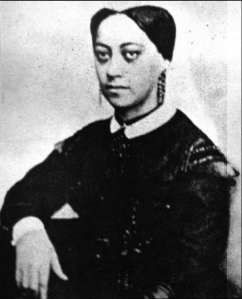 Called “the Mother of Civil Rights in California” from work she initiated in the 1860s, Mary Ellen Pleasant’s achievements in the struggle for the rights of Black people and women went unsurpassed until the 1960s.
Called “the Mother of Civil Rights in California” from work she initiated in the 1860s, Mary Ellen Pleasant’s achievements in the struggle for the rights of Black people and women went unsurpassed until the 1960s.
Pleasant was once the most talked-about woman in San Francisco. When other African Americans were rarely mentioned, she claimed full-page articles in the press. She helped shape early San Francisco, and covertly amassed a joint fortune once assessed at $30,000,000.
Pleasant was born a slave near Augusta, Georgia in 1814, the daughter of Virginia governor John H. Pleasants’ son, John H. Pleasants, Jr. and an enslaved Haitian Vodoun priestess.
After witnessing the death of her mother at the cruel hands of a plantation overseer, Mary Pleasant had to make her way through life largely on her own.
Pleasant dropped the ‘s’ in her last name, changing it to ‘Pleasant’ and fled to New Orleans, where she found employment as a linen worker at the Ursaline Convent. A short time later, she went to work as a free servant for a Louis Alexander Williams, a merchant in Cincinnati. Williams promised that, after Mary served the Williams family for some time without pay, she would be freed legally. However, Williams, in debt and ultimately jealous of his wife Ellen’s affection for young Mary Pleasant, eventually placed her into nine years of indentured servitude with an aging Quaker merchant known only as Grandma Hussey. Indentured servants could be of any race, and Pleasant, a child of mixed parentage, who in her earlier years was of a very light complexion, was told not to reveal her race – a heavy burden for a girl of about eleven.
Pleasant adopted Ellen Williams’ name, becoming “Mary Ellen Williams” and she learned business as a clerk in Grandma Hussey’s general store. Although she could not read or write then, she said in her final memoir, “I could recall the accounts of a whole day, and she [Grandma Hussey] would set them down and they would be right as I remembered ‘em.”
Pleasant grew smart and witty, and adopted abolitionist beliefs and the principles of equality that those beliefs taught her.
Later in the 1840′s, when her indentured service had ended, the Husseys helped the brilliant and talented twenty-something, young woman, become a tailor’s assistant in Boston. She also became a paid church soloist there.
Mary Ellen Williams soon met and married James W. Smith, a wealthy free Black who passed for white, so as to serve as a Southern contributor to William Lloyd Garrison’s abolitionist paper and a conductor on the Underground Railroad. Soon both Smiths served on that Railroad, helping slaves escape to freedom in Canada, Nova Scotia, and Mexico.
James Smith owned a plantation near Harper’s Ferry, left to him by his white father. Smith staffed it with freed slaves, whose freedom he helped secure. Smith died suddenly in 1844, leaving Mary Ellen a wealthy woman. She eventually remarried, but she continued her work as a conductor on the Underground Railroad between New Bedford, MA, and Ohio out of her own inner calling. She soon became a much-hunted slave rescuer.
Finally, in 1851, with slavers hot on her trail, she fled West.
According to ships records and confirming testimony, she arrived in San Francisco in April, 1852 to escape persecution under the Fugitive Slave Law of 1850, for helping hundreds of slaves escape.
 Before her arrival in what would become her permanent home, however, Mary Ellen stayed a year in New Orleans, continuing her studies of Vodoun she originally began with her mother with the Voodoo Queen, Mam’zelle Marie Laveau. From Mam’zelle Laveau Mary not only learned the herbal remedies and rituals of Vodoun, but also how to mentor her people and to manipulate the secrets of the rich to gain aid for the poor – a ‘model’ that would serve her well in San Francisco. After her intensive training was complete, Mary Ellen fled to San Francisco, assisted by Marie Laveau.
Before her arrival in what would become her permanent home, however, Mary Ellen stayed a year in New Orleans, continuing her studies of Vodoun she originally began with her mother with the Voodoo Queen, Mam’zelle Marie Laveau. From Mam’zelle Laveau Mary not only learned the herbal remedies and rituals of Vodoun, but also how to mentor her people and to manipulate the secrets of the rich to gain aid for the poor – a ‘model’ that would serve her well in San Francisco. After her intensive training was complete, Mary Ellen fled to San Francisco, assisted by Marie Laveau.
San Francisco was a rough and tumble, fast-paced place, inhabited by 40,000 people, and home to 700 drinking and gambling establishments, and 5 murders every 6 days.
In addition to those staggering statistics for that time, there were six men to every woman. San Francisco was not a safe place, but Mary Ellen Pleasant was up to the challenge. She was forced to use two identities to thwart capture under California’s Fugitive Slave Act. Under this law anyone without freedom papers could be captured and sent into slavery. Pleasant had no papers, So she lived as both “Mrs. Ellen Smith”, a white boardinghouse steward / cook and as “Mrs. Pleasants”, an abolitionist / entrepreneur). As Mrs. Smith, she served the wealthiest and most influential men in San Francisco and using their regard for her as well as the “Laveau model” of leveraging their secrets for favors, she was able to get jobs and privileges for “colored” people in San Francisco. It is this work that earned her the nickname “The Black City Hall”.
In the “colored” community, in her true identity as Mrs. Pleasants, she used her money to help ex-slaves fight unfair laws and to get lawyers or businesses in California. She became an expert capitalist, owning every kind of business imaginable, and she prospered. However, her people suffered as European immigrations took the menial jobs once held for them and as anti-black sentiment and national depression mounted. So, in 1858 Mary decided to return East – not to live, but – as she once said in a letter – to help her former brother in law gain release from slavery and to help abolitionist John Brown end slavery forever.
In Canada, she bought land on Campbell Street, near Harper’s Ferry, Virginia to help John Brown house the slaves that he planned to free. John Brown’s plan was to capture the Federal arsenal there with only 21 men. He would set up a maroon-like militia, made up of runaway slaves throughout the Virginia Mountains, as the Haitians had done. Then, he would shuttle some slaves from there to Canada. Mary gave Brown money for arms and came back the following fall to ride – in disguise as a jockey – in advance of Brown to alert slaves near Harper’s Ferry of his coming. It was a good, but risky, plan, but, unlike some other Black leaders, Pleasant, believing that slavery had to be ended by force, was willing to help. “I’d rather be a corpse than a coward,” was always her motto.
Of course, Brown acted too soon and was hanged, and Pleasant narrowly escaped with her life. On her return to California, however, she continued to fight, and after the Emancipation Proclamation and the California Right-of-Testimony of 1863 law, she declared her race openly.
She orchestrated court battles to test the right of testimony, and in 1868 her battle for the right of Blacks to ride the San Francisco trolleys without fear of discrimination set precedent in the California Supreme Court.
Mary Pleasant went on to become celebrated as a philanthropist and business woman and to amass a $30,000,000 fortune with her secret partner, Scotsman, Thomas Bell and today, the Voodoo Queen of California’s legacy of love and courage lives on.
Gbêhanzin (Béhanzin) Hossu Bowelle (1844 – 1906)
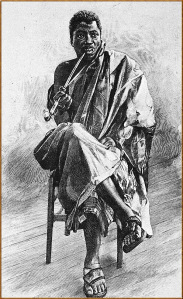 Gbêhanzin Hossu Bowelle or the ‘King Shark‘ was one the most powerful kings in West Africa at the turn of the 19th Century. He was the eleventh king of Dahomey, and the last independent ruler of Abomey before French colonization.
Gbêhanzin Hossu Bowelle or the ‘King Shark‘ was one the most powerful kings in West Africa at the turn of the 19th Century. He was the eleventh king of Dahomey, and the last independent ruler of Abomey before French colonization.
Gbehanzin was also reputed to be a fierce and powerful Vodou Priest, famously noted for hanging a witch or sorcerer alive from a pole as a warning to all who would dare to cross spiritual forces with him. He was never found without his trademark pipe and according to legend emerged from the womb smoking. Gbehanzin controlled a private army of female soldiers, the Dahomey Amazons, who were said to have fought more fiercely than men, sharpening their teeth into points to tear at their opponents’ carotid arteries.
In 1882, France declared a protectorate over Porto Novo, a vassal state of Abomey, without consulting with the indigenous people. By 1885, the French occupied the entire coastal strip West of Porto Novo. In 1889, King Glèlè and his son Gbehanzin, who considered these coastal areas to be part of the kingdom of Dahomey, declared that the Fon people could no longer tolerate France’s actions.
In February 1890, the French occupied Cotonou. Gbehanzin, now king after Glele’s sudden death, prepared for war. Gbehanzin’s forces attacked the French simultaneously on two fronts – militarily at Cotonou and economically by destroying the palm plantations at Porto Novo. The latter precipitated an early end to the hostilities. A treaty was signed, with the French continuing to occupy Cotonou, for which Gbehanzin exacted an annuity; he made France pay for the use of Cotonou port. The peace lasted for two years. However, France was determined to annex Dahomey before the British or Germans did. Gbehanzin, knowing that he would have to defend his sovereignty, continued upgrading his army in preparation for renewed war.
He declared a treaty made with France by his father, Glèlè, in1868 null and void. From this act, war began.
Gbehanzin led the final struggle against French colonial forces, but would ultimately succumb to Colonel Alfred-Amédée Dodds, a Senegalese warrior, who was sent to fight against Gbehanzin with powerful French armed forces under his command. Colonel Dodds’ division defeated Gbehanzin not by the French directly besting Dahomey in combat, but because part of Dodd’s campaign was the deforestation of sacred trees, areas of arbors believed to house the spirits of ancestors and to give strength to the Dahomey people (now you know where they got that scene in Avatar from). It was only after a significant number of the trees were cut that the French were able to break through the Dahomey forces and drive Gbehanzin into exile.
Gbehanzin died in 1906 in Algeria. In 1928, his son, Ouanilo (who was also France’s first African attorney in 1920) had his body moved to Dahomey.
Benjamin “Black Herman” Rucker (1892 – 1934)
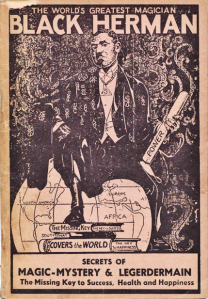 Black Herman was born Benjamin Rucker in Virginia in 1892.
Black Herman was born Benjamin Rucker in Virginia in 1892.
Rucker came of age under the tutelage of an itinerant African-American showman and street peddler by the name of Alonzo Moore, who went by the name ‘Prince Herman’. Moore took in Rucker as an apprentice at the age of sixteen. By the time of Prince Herman’s death a few years later, Rucker had fine-tuned his own skills at reading cards, divining fortunes, and cooking up healing elixirs, so much that he was able to make his own way around the circuit of traveling faith healers who hustled material goods and spiritual assurances from town to town in Black Belt communities.
Eventually, poverty and racial discrimination pushed Rucker out of the South and toward Chicago, where in the late 1910s he launched an independent career. Assuming a new name borrowed from his old friend and mentor, Prince Herman, Rucker became known as ‘Black Herman’.
Black Herman was a master of conventional magic techniques and legerdemain, successfully crossing the boundaries between theater, folk religion, the black vernacular traditions and entrepreneurship and mixing them all up into a powerful and entertaining gumbo. Echoes of a mysterious, powerful constellation of folk supernaturalism, occult arts, and ancestral religiosity are what defined Black Herman’s performance style. This appropriation of worlds both distinctly African and African-American was as resonant with audiences as it was profitable for him.
Black Herman found his place as the self-proclaimed “world’s greatest magician” in Harlem, the African American Mecca during the Jazz Age.
It was in Harlem that Herman mass-marketed the act for which he became best known – a combination of stage craft, comedy, vaudeville theater, religious oratory, and mind-reading tricks.
Herman’s crowning achievement was a headlining show at Marcus Garvey’s four-thousand-seat Liberty Hall in 1923. Hugely appealing to an emerging urban audience – a highly mixed demographic that included Blacks, whites, members of high society and other elites, and men and women of the working classes – Herman sold out at Liberty Hall for a month and continued to sell out every time he performed.
Equally at home as a merchant of conjuring implements and as a storefront impresario, Herman set up shop as an authorized seller of mail order courses, lucky numbers, and health tonics until he was arrested in 1925 and sent to Sing-Sing on a charge of fraud.
Prison did not dissuade him from his true calling, however, and by the end of the decade Herman had returned to the stage and his extraordinarily lucrative career.
Black Herman’s public career came to an abrupt end when he collapsed onstage after a show at the Palace Theatre in Louisville, Kentucky, in 1934. Members of the audience could not determine whether Herman’s departure was part of the act or not. After all, one of his most famous tricks involved the staging of his own burial and resurrection. When Black Herman’s body was ultimately laid to rest at New York’s Woodlawn cemetery, newspapers reported that scores of visitors gathered in anticipation of his rising from the grave.
The author Arthur C. Clarke said “Any sufficiently advanced technology is indistinguishable from magic.” Then Steamfunk and Steampunk can be said to be magical. How does magic affect or influence you, Steampunks and Steamfunkateers? What has been magical about your life?


January 21, 2013
IT’S STILL DARK AT TWILIGHT: Scrubbing off the Whitewash of Urban Fantasy!
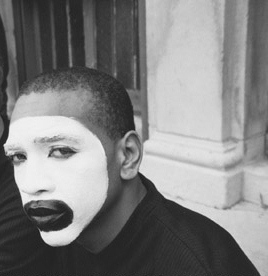 Whitewashing is the practice in which an author, filmmaker, artist or fan takes a character who is originally of color in literature and / or film and replaces them with a white character, actor, or model, or a person who looks “more white”, in order to appeal to the white masses.
Whitewashing is the practice in which an author, filmmaker, artist or fan takes a character who is originally of color in literature and / or film and replaces them with a white character, actor, or model, or a person who looks “more white”, in order to appeal to the white masses.
Whitewashing is also used to describe the entertainment industry’s erasure of People of Color from history and / or specific locales.
This practice is extremely prevalent in Urban Fantasy.
Fans of Urban Fantasy often give the excuse that because most Urban Fantasy is set in a rural town, the percentage of People of Color who populate those towns is so insignificant that inclusion of them is pointless and even unrealistic.
This would almost make sense if the problematic subgenre was Rural Fantasy. The issue at hand, however, is Urban Fantasy.
Human settlements are classified as rural or urban depending on the density of human-created structures and resident people in a particular area. Urban areas can include towns and cities while rural areas include villages and hamlets.
 Rural areas are settled places outside towns and cities, that often develop randomly on the basis of natural vegetation and fauna available in a region. They can have an agricultural feel to them – think the village in Children of the Corn, or Mayberry, with Andy, Otis, Opie, Barney and Gomer Pyle all gathered at Floyd Lawson’s Barbershop enjoying Aunt Bee’s apple pie.
Rural areas are settled places outside towns and cities, that often develop randomly on the basis of natural vegetation and fauna available in a region. They can have an agricultural feel to them – think the village in Children of the Corn, or Mayberry, with Andy, Otis, Opie, Barney and Gomer Pyle all gathered at Floyd Lawson’s Barbershop enjoying Aunt Bee’s apple pie.
 Unlike rural areas, urban settlements are defined by their advanced civic amenities, opportunities for education, facilities for transport, business and social interaction and overall better standard of living. Socio-cultural statistics are usually based on an urban population – think Chicago, Atlanta and New York City.
Unlike rural areas, urban settlements are defined by their advanced civic amenities, opportunities for education, facilities for transport, business and social interaction and overall better standard of living. Socio-cultural statistics are usually based on an urban population – think Chicago, Atlanta and New York City.
So, why in the hell would Urban Fantasy be chiefly set in a Mayberry, when it clearly should be set in Chi-Town? We should change the subgenre of these stories to Rural Fantasy. Believe me; the complaints of whitewashing would end then; especially from me, because I would never bother to pick one of those books up.
Now before one of you fanboys rants about Jim Butcher setting his Harry Dresden books in Chicago, let’s explore this fact a bit deeper.
Yes, both Jim Butcher’s Harry Dresden Series and Chloe Neill’s Chicagoland Vampires, are set in “Chicago”. This is obviously a very different Windy City from where I grew up and spent most of my life, however, because my Chicago is only 40% white. Yet Butcher’s and Neill’s Chicago’s are about 99% white. It’s like they took big bottles of White-Out and went berserk. Their works are, most certainly, about as fantastical as writing can get, perhaps even farcical. But Urban? Nah.
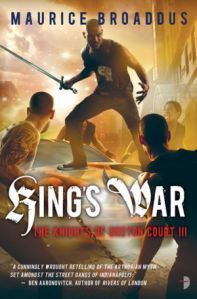 Speculative fiction author Maurice Broaddus, in his article entitled Putting the Urban in Urban Fantasy, says:
Speculative fiction author Maurice Broaddus, in his article entitled Putting the Urban in Urban Fantasy, says:
“About a year ago, Jim Butcher’s Twitter feed erupted into a bit of a kerfuffle about the whitewashing of urban fantasy. Apparently folks were bent out of shape by his depiction of Chicago, essentially whitewashing it as his Chicago comes up a bit short on the amount of black folks (or other people of color) living there. Frankly, I wasn’t too bent out of shape over this as somehow every week people used to tune into Friends who lived in a New York remarkably bereft of black folks. It’s to the point where I go into an urban fantasy expecting not to encounter minority characters other than in a ‘magical Negro’-type capacity.”
He goes on to say:
“There are more stories to tell in urban fiction than Boyz N the Hood or Menace II Society or baby mama dramas. Just as there are more characters to write about in urban fantasy whose stories aren’t as often told or voices always expressed. With the legends of the Green Knight, Red Knight, and Black Knight (in each of the books, respectively), Tristan and Isolde, trolls, zombies, a dragon, elven assassins, Red Caps, griffins, gangstas, and thug life tossed in, I guess I’m putting the “urban” in urban fantasy. This isn’t your father’s King Arthur tale, but it is mine.”
No Rural Fantasy with Maurice Broaddus’ Knights of Breton Court series. This magnificent series is pure Urban Fantasy at its very best.
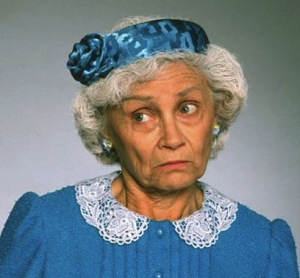 Come on, y’all…if you write a story and set it in a place like Broaddus’ Indianapolis, Chicago, Atlanta, London, or Las Vegas, basic demographic research will indicate the presence of People of Color. To read and enjoy Urban Fantasy, I am expected to just accept that Black people don’t exist? You get the side-eye for that one.
Come on, y’all…if you write a story and set it in a place like Broaddus’ Indianapolis, Chicago, Atlanta, London, or Las Vegas, basic demographic research will indicate the presence of People of Color. To read and enjoy Urban Fantasy, I am expected to just accept that Black people don’t exist? You get the side-eye for that one.
Whether or not you like Urban Fantasy, the fact of the matter is that this subgenre of Fantasy has had an immense and global impact on people through literature, television and film.
It is because of this impact that we cannot ignore the messages that Urban Fantasy brings. Each time an author of this subgenre decides to tell a story, instead of working so hard to erase People of Color out of existence, they should work just as hard to erase the problems that plague our society. And fanboys…do not say that writers should not have to be political; that they should be free to write merely to entertain. Every statement we make is political. Every sentence we write is potentially life-changing for someone. Such is the power of the word.
You cannot truly change culture without literature. We can pass a thousand laws saying that racism and sexism are wrong. We can make a thousand impassioned speeches to rouse the marginalized masses; but if everyone returns home after those speeches and sits down to read the latest installment of Twilight, or watch the next episode of The Vampire Diaries and their fictional worlds in which those same marginalized masses barely even exist – then how much change can truly be affected?
It is within the pages of books and under the light of the TV screen where we will reach people and change the world for the better…or worse.
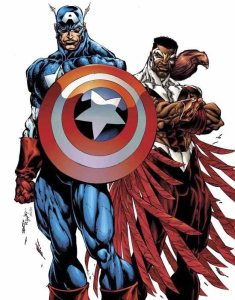 Over and over again, we are told that our stories aren’t worth being told. We do not get to be the heroes. We are never “the one destined to come since man was young upon the earth”. If we are lucky, we get to be the “magical negro”; the “noble savage”; the sidekick; the Black person who doesn’t die in the first ten minutes of the film.
Over and over again, we are told that our stories aren’t worth being told. We do not get to be the heroes. We are never “the one destined to come since man was young upon the earth”. If we are lucky, we get to be the “magical negro”; the “noble savage”; the sidekick; the Black person who doesn’t die in the first ten minutes of the film.
This is damaging to the psyches of People of Color. And a devastating blow to the self-esteem of our babies.
So, don’t tell me writers just write to merely entertain, when entertainment has such a powerful, deep and lasting impression on the minds of us all.
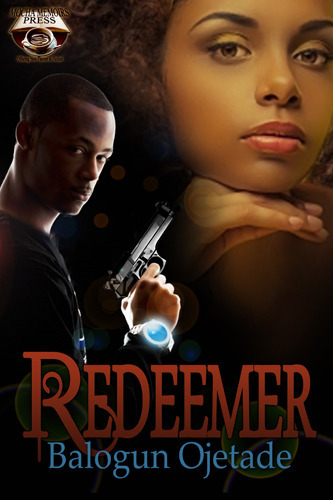 This is why Black speculative fiction is so important. In my own work of Urban Fantasy, Redeemer, the hero, Ezekiel Cross, is a Black man from an Atlanta of the future who is used in an experiment that transports him to an Atlanta of the past – our present. This Atlanta is a gritty, real Atlanta in which intelligent and powerful Black people – both good and bad – exist.
This is why Black speculative fiction is so important. In my own work of Urban Fantasy, Redeemer, the hero, Ezekiel Cross, is a Black man from an Atlanta of the future who is used in an experiment that transports him to an Atlanta of the past – our present. This Atlanta is a gritty, real Atlanta in which intelligent and powerful Black people – both good and bad – exist.
Redeemer is witty, thrilling and, sometimes, frightening Urban Fantasy that I have always wanted to read; with heroes I have always wanted to see.
Will it change the world? Maybe…give it a read and let me know.


January 19, 2013
DOROTHY, WE AIN’T IN KANSAS ANYMORE: The Building of a Non-Eurocentric Fantasy World!
DOROTHY, WE AINT IN KANSAS ANYMORE
The Building of a Non-Eurocentric Fantasy World
 I grew up on science fiction and fantasy, loving both genres equally, however, when I discovered Dungeons and Dragons back in 1981, my greatest love became fantasy. Forced into game-mastering due to the racism of the white students who refused to teach Black students to play, or treated us like “orcs” when they did teach us, my storytelling grew from the simple stories about Shaft, Billie Jack, Luke Cage and the Falcon I would tell to entertain my friends and family, to the building of worlds inhabited by complex characters. Fantasy worlds filled with intrigue, adventure, horror and humor.
I grew up on science fiction and fantasy, loving both genres equally, however, when I discovered Dungeons and Dragons back in 1981, my greatest love became fantasy. Forced into game-mastering due to the racism of the white students who refused to teach Black students to play, or treated us like “orcs” when they did teach us, my storytelling grew from the simple stories about Shaft, Billie Jack, Luke Cage and the Falcon I would tell to entertain my friends and family, to the building of worlds inhabited by complex characters. Fantasy worlds filled with intrigue, adventure, horror and humor.
Wanting to tell better Fantasy stories and to create a richer world for the players in my Dungeons and Dragons campaign, I became a voracious reader of fantasy novels, reveling in the richly-textured worlds of J.R.R. Tolkien, C.S. Lewis and Robert E. Howard.
After two years of enthusiastic play, however, I – and my friends, it turned out – was tired of playing such a Eurocentric game. We had grown tired of lands that were obvious representations of England, Germany and Russia. These settings were not offering us anything new; anything we had not seen in slightly different forms over and over again.
 To make the game interesting, many of my friends would create a character that was a ninja or samurai – because they were people of color, which made them unique and because they were ninjas and samurai, which made them cool. When I decided to introduce a Mandinka king who had come to the Land of Nod – we called all Eurocentric settings that because, for us, they had become boring and powerful sleep-inducers – to hunt the vampires who murdered his family, however, our interest in the game resurged. The players in my group begged to have their characters accompany the king back to Mali once they helped kill the vampire hordes infesting the Land of Nod. I agreed and everyone went into a frenzy – they, to find armor, clothing, weapons and spells appropriate to the terrain; I, to research ancient Mali and African folklore, creature lore and social, military and ecological systems and to create a world worthy of my players and of Africa.
To make the game interesting, many of my friends would create a character that was a ninja or samurai – because they were people of color, which made them unique and because they were ninjas and samurai, which made them cool. When I decided to introduce a Mandinka king who had come to the Land of Nod – we called all Eurocentric settings that because, for us, they had become boring and powerful sleep-inducers – to hunt the vampires who murdered his family, however, our interest in the game resurged. The players in my group begged to have their characters accompany the king back to Mali once they helped kill the vampire hordes infesting the Land of Nod. I agreed and everyone went into a frenzy – they, to find armor, clothing, weapons and spells appropriate to the terrain; I, to research ancient Mali and African folklore, creature lore and social, military and ecological systems and to create a world worthy of my players and of Africa.
 From this experience, I learned that a writer has to do three things in order to create a fantasy world that is real enough for readers to escape to; to immerse themselves in; to feel:
From this experience, I learned that a writer has to do three things in order to create a fantasy world that is real enough for readers to escape to; to immerse themselves in; to feel:
a) Know it personally.
b) Research; research; research.
c) Make it up.
For my friends who do not write fiction, you probably think that writers of fantasy rely entirely on “making it up”, but you would be wrong. For the most part, fantasy worlds – just like worlds in hard-boiled crime, horror and romance – are based on something. Very often, fantasy worlds are an altered or hybridized version of a pre-modern, non-technological human society, which means, to create a world that readers will accept as real, you gotta research, research, research!
 The best places to find new ideas for fantasy world-building are in reading about history, culture and “real-world” systems of belief.
The best places to find new ideas for fantasy world-building are in reading about history, culture and “real-world” systems of belief.
If an author’s only research is other fantasy novels, he or she will wind up borrowing Eurocentric milieus from the rest of the genre – and give us even more cliché from the Land of Nod.
A world based on Europe or West Asia is no problem, as long as, when immersed in your world, we don’t expect Conan, Bilbo Baggins, or The Gray Mouser to hop out from behind a bush and shout “Surprise!”
We need more worlds like Charles Saunders’ Nyumbani – “home” in Swahili – a world based on the traditions, legends and lands of Africa. Saunders, the founder and father of the fantasy subgenre Sword and Soul, has created a world that is fantastic, yet very real. Nyumbani is home to Saunders’ Imaro, one of the greatest and most interesting heroes in the history of fantasy fiction.
Taking inspiration from Charles Saunders, authors Milton J. Davis and Balogun Ojetade (full disclosure: that’s me), no strangers to world-building themselves, joined forces to create Ki-Khanga, a unique world that draws readers in and keeps them there. What, exactly is Ki-Khanga? How does this world “work”? Well, Charles Saunders says it best:
“ Ki-Khanga is an Africa that could have been, located in a world that might have been. Sprung from the fertile minds of Milton J. Davis and Balogun Ojetade, Ki-Khanga is a place of magic and mystery, heroism and horror, spears and seduction. It is a place roiled by the long-reaching repercussions of an ancient feud between pre-human races and the subsequent wrath of an affronted deity. Not only does magic work in Ki-Khanga – magic defines Ki-Khanga, in more ways than one. ”
 I invite you to join us on the sandy shores, perilous mountains and mysterious savannahs of our world. I invite you to ride beneath the dunes of Targa in the bowels of the oga’koi-koi or to do battle with the Ndoko in the Great Circle. I invite you to share in our tales of triumph; of tragedy; of terror and tenacity.
I invite you to join us on the sandy shores, perilous mountains and mysterious savannahs of our world. I invite you to ride beneath the dunes of Targa in the bowels of the oga’koi-koi or to do battle with the Ndoko in the Great Circle. I invite you to share in our tales of triumph; of tragedy; of terror and tenacity.
I invite you to free yourself from the Land of Nod…and flee to Ki-Khanga!
Help us change the game by supporting our game! All the profits from the anthology will go to the development of Ki-Khanga: The Role-Playing Game.
We’re not asking you to Kickstart or Indiegogo, just purchase a copy of this exciting collection of stories by Balogun Ojetade and Milton J. Davis; with an amazing cover by world-renowned fantasy and science fiction artist, Eugene Randolph Young and a powerful introduction by the Father and Founder of Sword & Soul, Charles R. Saunders!
You get a great anthology now…and a great role-playing game later. It’s a win-win!
The anthology is now available for Kindle and Nook. Print copies are coming soon.
Sword and Soul forever!


January 12, 2013
PSYCHOLOGY, SANKOFA AND SWORD & SOUL: The Coming of Ki-Khanga!
PSYCHOLOGY, SANKOFA AND SWORD & SOUL: The Coming of Ki-Khanga!
 Fantasy often takes place in otherworldly settings – such as the planet Pandora, in the film Avatar – or a slightly different version of the world we know, such as Nyumbani, in Charles R. Saunders’ incomparable Imaro series of novels. The details that go into the imagining of a fantastical setting allow the writer to both ground a narrative in reality and challenge the notions of that reality.
Fantasy often takes place in otherworldly settings – such as the planet Pandora, in the film Avatar – or a slightly different version of the world we know, such as Nyumbani, in Charles R. Saunders’ incomparable Imaro series of novels. The details that go into the imagining of a fantastical setting allow the writer to both ground a narrative in reality and challenge the notions of that reality.
In Fantasy, the distractions of the mundane world are stripped away by the fantastical setting, and the remaining resemblances between the story world and our world are only those that really matter.
Fantasy stories do not explicate their authors’ philosophies; rather, they incarnate them and thereby put them to the test. If author Milton Davis’ readers find his seafaring Swahili prince, Changa Diop, beautiful, it is because Changa represents the high and noble in human nature that rings true, that persuades us, whether we realize it or not.
Too often, Fantasy stories are mistaken as diversions for the entertainment of children, stories that not only aren’t true, but could not possibly ever be true. Many Black people discourage their children from reading fantasy and certainly will not read it themselves because Fantasy dares to tell children to believe in fantastical things like wizards and monsters. Fantasy does not teach children that monsters exist…they already know that. Fantasy teaches them that monsters can be slain – a lesson we grown folks need to learn and internalize too!
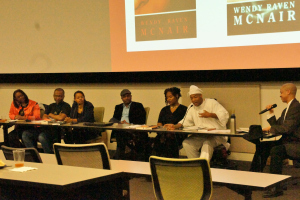 Recently, a few writing colleagues and I were guests at an annual festival that celebrates natural Black beauty, wellness and culture. We were invited to sit on a panel and discuss why Black people should read and write speculative fiction.
Recently, a few writing colleagues and I were guests at an annual festival that celebrates natural Black beauty, wellness and culture. We were invited to sit on a panel and discuss why Black people should read and write speculative fiction.
We were introduced by famed hip-hop artist and activist, Professor Griff of the famed Hip-Hop Group, Public Enemy (*sigh* yes, the same group to which Flavor Flav belongs), who spoke briefly before bringing us up.
When it was announced that we were discussing Fantasy and Science Fiction, the crowd of three hundred dwindled to twelve.
One of the authors was near tears and has since not shown up at any events where it is clear that a majority of Black people will be in attendance. She was shocked and hurt by the reaction of the festival’s attendees. She felt as if her own people had rejected her; perhaps even hated her for “selling out” to Fantasy and Science Fiction.
I was not shocked. These were “conscious” Black people and I know how so-called conscious Black people think, for I am one of them.
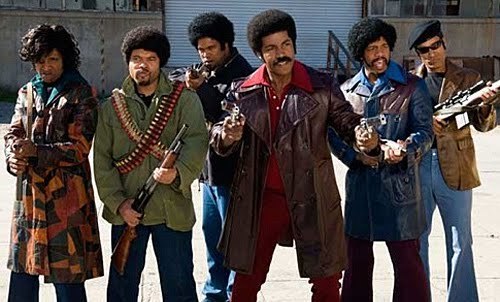 “Conscious” Black people are quick to accuse something of being trivial and a distraction from the work of awakening the ignorant masses of our people. And, to many of them, fiction is as trivial as you can get.
“Conscious” Black people are quick to accuse something of being trivial and a distraction from the work of awakening the ignorant masses of our people. And, to many of them, fiction is as trivial as you can get.
Damn the fact that our ancestors were master storytellers and conveyed most life-lessons and values through fiction. In fact, most traditional African cultures still have their Djeli, Sanusi, Babalawo, Iyanifa, Houngan, Mambo, Bokonon and other griots – keepers of the culture and history. And these storytellers are revered.
Damn the fact that every corner in the Black community has its storytellers; every mosque; every church; every barbershop.
Damn the fact that many of the Fantasy stories told by authors such as Yours Truly, Milton Davis, Valjeanne Jeffers and, of course, Charles Saunders are written in the subgenre of Sword and Soul and by writing such stories, these authors are applying the African principle of Sankofa.
 Sankofa is an Akan word that means, “One must return to the past in order to move forward.”
Sankofa is an Akan word that means, “One must return to the past in order to move forward.”
The symbol of Sankofa is that of a bird whose head is faced in the opposite direction of its body. This illustrates the fact that even though the bird is advancing, it periodically makes it a point to examine / return to its past, since this is the only way for one to have a better future.
Some also interpret Sankofa to mean, “No matter how far away one travels they must always return home.”
However Sankofa is interpreted, the basic and important meaning remains – your past is an important aspect of your future. So, in order to make the best of your future, you must visit your past.
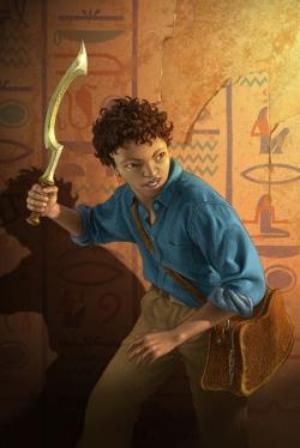 Fantasy stories carry readers beyond the restrictions of time and space and promote a sense of mystery and transcendence, helping readers envision a better society where intelligence, courage, and compassion prevail.
Fantasy stories carry readers beyond the restrictions of time and space and promote a sense of mystery and transcendence, helping readers envision a better society where intelligence, courage, and compassion prevail.
They awaken higher ideals without preaching and show how the small and powerless can triumph through perseverance and patience.
. Conscious, or otherwise.
Balogun Ojetade, author of the Sword and Soul novel, Once Upon A Time In Afrika and Milton J. Davis, publisher and author of the Meji and Changa’s Safari Sword & Soul series, have come together to create a world of mystery; a world of magic; a world of warriors and Gods of Light and Darkness.
In mid-January, 2013, the Ki-Khanga Anthology arrives, with tales of our past – both dark and glorious – that will offer an escape from our present and pathways to our future.



